Entrepreneurship & Small Business Management
VerifiedAdded on 2022/12/23
|19
|5066
|33
AI Summary
This report explores different types of entrepreneurial ventures, their similarities and differences, and their impact on the economy. It also discusses the characteristics and skills of successful entrepreneurs and how background and experience can affect entrepreneurship.
Contribute Materials
Your contribution can guide someone’s learning journey. Share your
documents today.

Entrepreneurship &
Small Business
Management
Small Business
Management
Secure Best Marks with AI Grader
Need help grading? Try our AI Grader for instant feedback on your assignments.
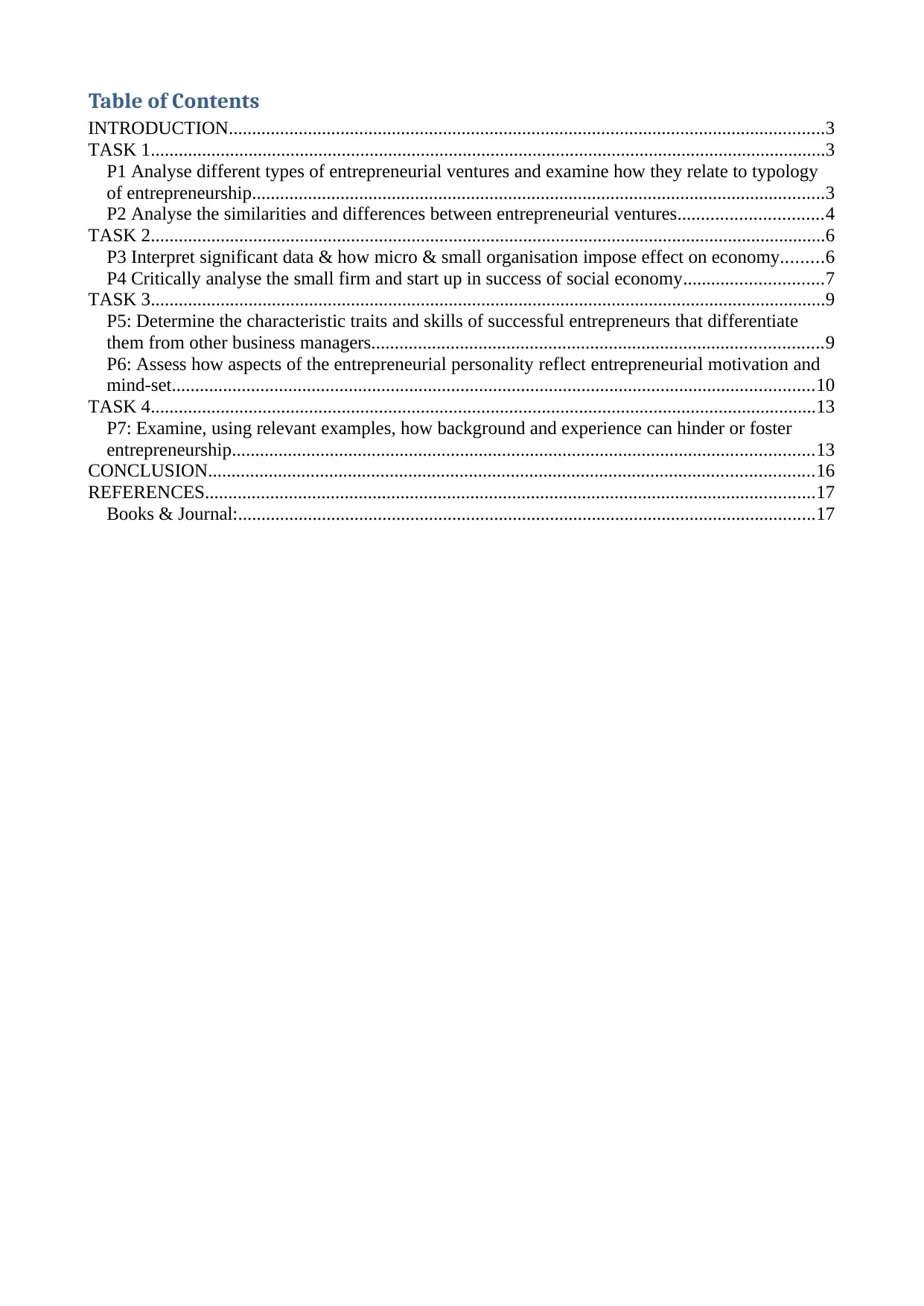
Table of Contents
INTRODUCTION................................................................................................................................3
TASK 1.................................................................................................................................................3
P1 Analyse different types of entrepreneurial ventures and examine how they relate to typology
of entrepreneurship...........................................................................................................................3
P2 Analyse the similarities and differences between entrepreneurial ventures...............................4
TASK 2.................................................................................................................................................6
P3 Interpret significant data & how micro & small organisation impose effect on economy.........6
P4 Critically analyse the small firm and start up in success of social economy..............................7
TASK 3.................................................................................................................................................9
P5: Determine the characteristic traits and skills of successful entrepreneurs that differentiate
them from other business managers.................................................................................................9
P6: Assess how aspects of the entrepreneurial personality reflect entrepreneurial motivation and
mind-set..........................................................................................................................................10
TASK 4...............................................................................................................................................13
P7: Examine, using relevant examples, how background and experience can hinder or foster
entrepreneurship.............................................................................................................................13
CONCLUSION..................................................................................................................................16
REFERENCES...................................................................................................................................17
Books & Journal:............................................................................................................................17
INTRODUCTION................................................................................................................................3
TASK 1.................................................................................................................................................3
P1 Analyse different types of entrepreneurial ventures and examine how they relate to typology
of entrepreneurship...........................................................................................................................3
P2 Analyse the similarities and differences between entrepreneurial ventures...............................4
TASK 2.................................................................................................................................................6
P3 Interpret significant data & how micro & small organisation impose effect on economy.........6
P4 Critically analyse the small firm and start up in success of social economy..............................7
TASK 3.................................................................................................................................................9
P5: Determine the characteristic traits and skills of successful entrepreneurs that differentiate
them from other business managers.................................................................................................9
P6: Assess how aspects of the entrepreneurial personality reflect entrepreneurial motivation and
mind-set..........................................................................................................................................10
TASK 4...............................................................................................................................................13
P7: Examine, using relevant examples, how background and experience can hinder or foster
entrepreneurship.............................................................................................................................13
CONCLUSION..................................................................................................................................16
REFERENCES...................................................................................................................................17
Books & Journal:............................................................................................................................17
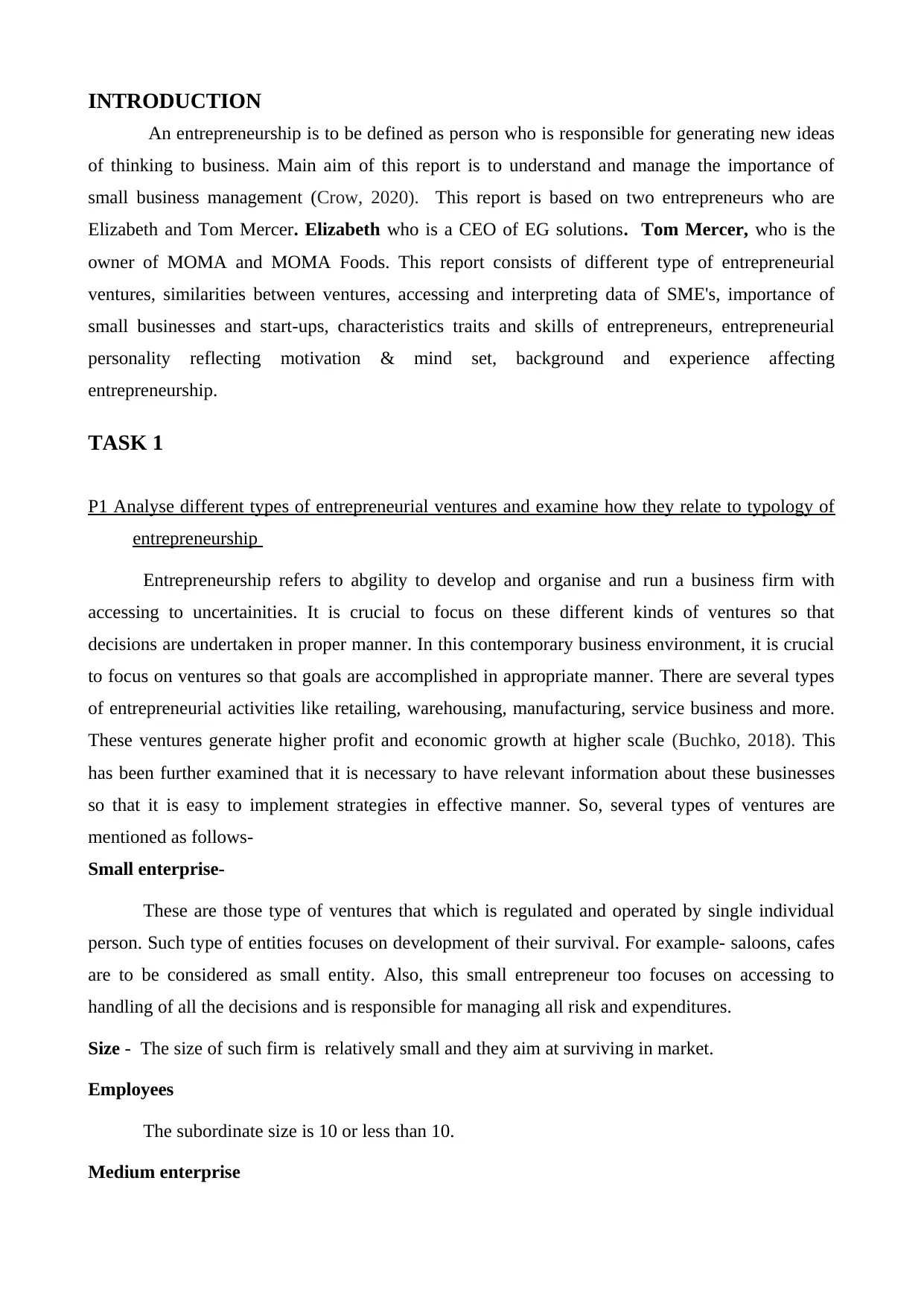
INTRODUCTION
An entrepreneurship is to be defined as person who is responsible for generating new ideas
of thinking to business. Main aim of this report is to understand and manage the importance of
small business management (Crow, 2020). This report is based on two entrepreneurs who are
Elizabeth and Tom Mercer. Elizabeth who is a CEO of EG solutions. Tom Mercer, who is the
owner of MOMA and MOMA Foods. This report consists of different type of entrepreneurial
ventures, similarities between ventures, accessing and interpreting data of SME's, importance of
small businesses and start-ups, characteristics traits and skills of entrepreneurs, entrepreneurial
personality reflecting motivation & mind set, background and experience affecting
entrepreneurship.
TASK 1
P1 Analyse different types of entrepreneurial ventures and examine how they relate to typology of
entrepreneurship
Entrepreneurship refers to abgility to develop and organise and run a business firm with
accessing to uncertainities. It is crucial to focus on these different kinds of ventures so that
decisions are undertaken in proper manner. In this contemporary business environment, it is crucial
to focus on ventures so that goals are accomplished in appropriate manner. There are several types
of entrepreneurial activities like retailing, warehousing, manufacturing, service business and more.
These ventures generate higher profit and economic growth at higher scale (Buchko, 2018). This
has been further examined that it is necessary to have relevant information about these businesses
so that it is easy to implement strategies in effective manner. So, several types of ventures are
mentioned as follows-
Small enterprise-
These are those type of ventures that which is regulated and operated by single individual
person. Such type of entities focuses on development of their survival. For example- saloons, cafes
are to be considered as small entity. Also, this small entrepreneur too focuses on accessing to
handling of all the decisions and is responsible for managing all risk and expenditures.
Size - The size of such firm is relatively small and they aim at surviving in market.
Employees
The subordinate size is 10 or less than 10.
Medium enterprise
An entrepreneurship is to be defined as person who is responsible for generating new ideas
of thinking to business. Main aim of this report is to understand and manage the importance of
small business management (Crow, 2020). This report is based on two entrepreneurs who are
Elizabeth and Tom Mercer. Elizabeth who is a CEO of EG solutions. Tom Mercer, who is the
owner of MOMA and MOMA Foods. This report consists of different type of entrepreneurial
ventures, similarities between ventures, accessing and interpreting data of SME's, importance of
small businesses and start-ups, characteristics traits and skills of entrepreneurs, entrepreneurial
personality reflecting motivation & mind set, background and experience affecting
entrepreneurship.
TASK 1
P1 Analyse different types of entrepreneurial ventures and examine how they relate to typology of
entrepreneurship
Entrepreneurship refers to abgility to develop and organise and run a business firm with
accessing to uncertainities. It is crucial to focus on these different kinds of ventures so that
decisions are undertaken in proper manner. In this contemporary business environment, it is crucial
to focus on ventures so that goals are accomplished in appropriate manner. There are several types
of entrepreneurial activities like retailing, warehousing, manufacturing, service business and more.
These ventures generate higher profit and economic growth at higher scale (Buchko, 2018). This
has been further examined that it is necessary to have relevant information about these businesses
so that it is easy to implement strategies in effective manner. So, several types of ventures are
mentioned as follows-
Small enterprise-
These are those type of ventures that which is regulated and operated by single individual
person. Such type of entities focuses on development of their survival. For example- saloons, cafes
are to be considered as small entity. Also, this small entrepreneur too focuses on accessing to
handling of all the decisions and is responsible for managing all risk and expenditures.
Size - The size of such firm is relatively small and they aim at surviving in market.
Employees
The subordinate size is 10 or less than 10.
Medium enterprise
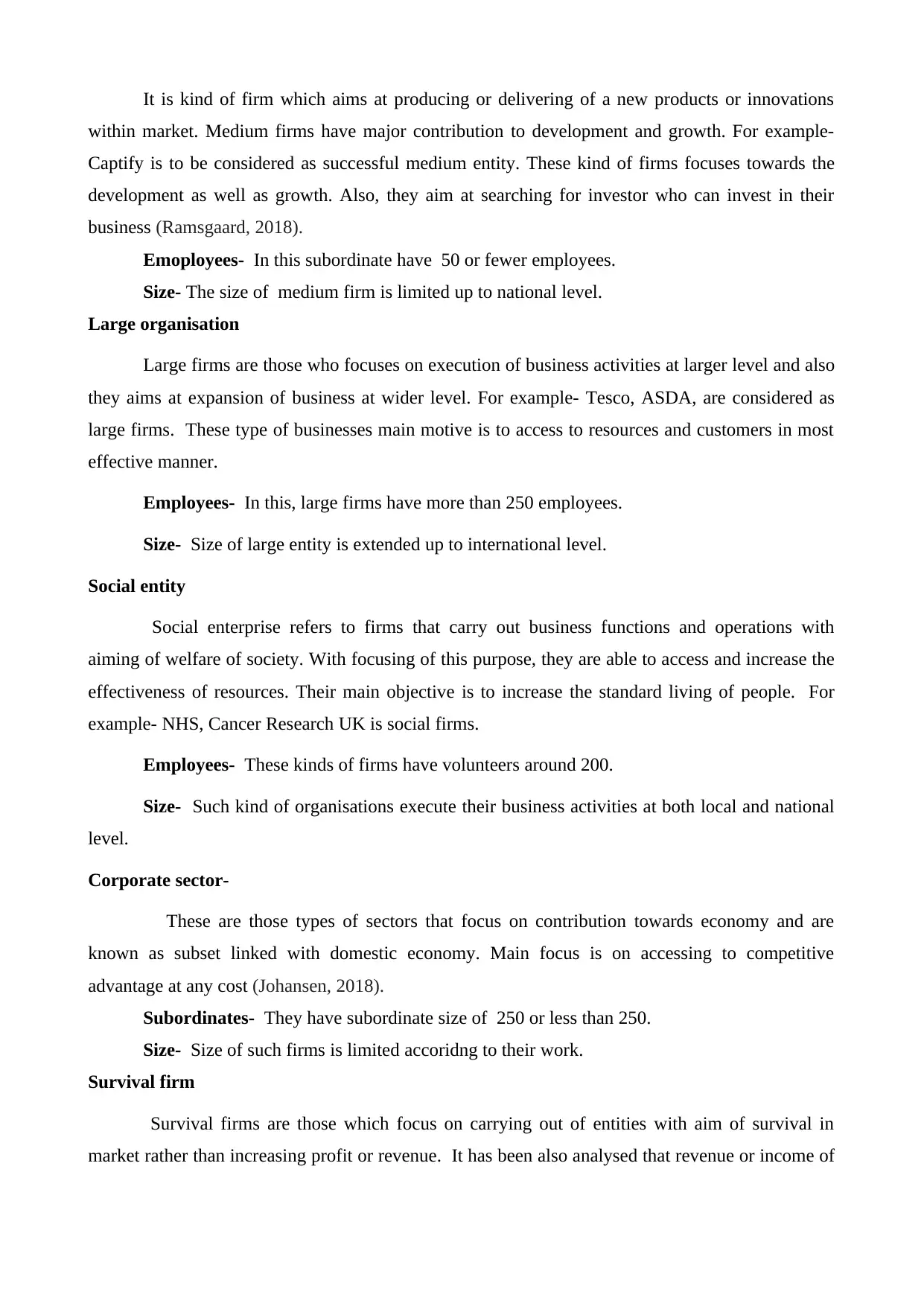
It is kind of firm which aims at producing or delivering of a new products or innovations
within market. Medium firms have major contribution to development and growth. For example-
Captify is to be considered as successful medium entity. These kind of firms focuses towards the
development as well as growth. Also, they aim at searching for investor who can invest in their
business (Ramsgaard, 2018).
Emoployees- In this subordinate have 50 or fewer employees.
Size- The size of medium firm is limited up to national level.
Large organisation
Large firms are those who focuses on execution of business activities at larger level and also
they aims at expansion of business at wider level. For example- Tesco, ASDA, are considered as
large firms. These type of businesses main motive is to access to resources and customers in most
effective manner.
Employees- In this, large firms have more than 250 employees.
Size- Size of large entity is extended up to international level.
Social entity
Social enterprise refers to firms that carry out business functions and operations with
aiming of welfare of society. With focusing of this purpose, they are able to access and increase the
effectiveness of resources. Their main objective is to increase the standard living of people. For
example- NHS, Cancer Research UK is social firms.
Employees- These kinds of firms have volunteers around 200.
Size- Such kind of organisations execute their business activities at both local and national
level.
Corporate sector-
These are those types of sectors that focus on contribution towards economy and are
known as subset linked with domestic economy. Main focus is on accessing to competitive
advantage at any cost (Johansen, 2018).
Subordinates- They have subordinate size of 250 or less than 250.
Size- Size of such firms is limited accoridng to their work.
Survival firm
Survival firms are those which focus on carrying out of entities with aim of survival in
market rather than increasing profit or revenue. It has been also analysed that revenue or income of
within market. Medium firms have major contribution to development and growth. For example-
Captify is to be considered as successful medium entity. These kind of firms focuses towards the
development as well as growth. Also, they aim at searching for investor who can invest in their
business (Ramsgaard, 2018).
Emoployees- In this subordinate have 50 or fewer employees.
Size- The size of medium firm is limited up to national level.
Large organisation
Large firms are those who focuses on execution of business activities at larger level and also
they aims at expansion of business at wider level. For example- Tesco, ASDA, are considered as
large firms. These type of businesses main motive is to access to resources and customers in most
effective manner.
Employees- In this, large firms have more than 250 employees.
Size- Size of large entity is extended up to international level.
Social entity
Social enterprise refers to firms that carry out business functions and operations with
aiming of welfare of society. With focusing of this purpose, they are able to access and increase the
effectiveness of resources. Their main objective is to increase the standard living of people. For
example- NHS, Cancer Research UK is social firms.
Employees- These kinds of firms have volunteers around 200.
Size- Such kind of organisations execute their business activities at both local and national
level.
Corporate sector-
These are those types of sectors that focus on contribution towards economy and are
known as subset linked with domestic economy. Main focus is on accessing to competitive
advantage at any cost (Johansen, 2018).
Subordinates- They have subordinate size of 250 or less than 250.
Size- Size of such firms is limited accoridng to their work.
Survival firm
Survival firms are those which focus on carrying out of entities with aim of survival in
market rather than increasing profit or revenue. It has been also analysed that revenue or income of
Secure Best Marks with AI Grader
Need help grading? Try our AI Grader for instant feedback on your assignments.
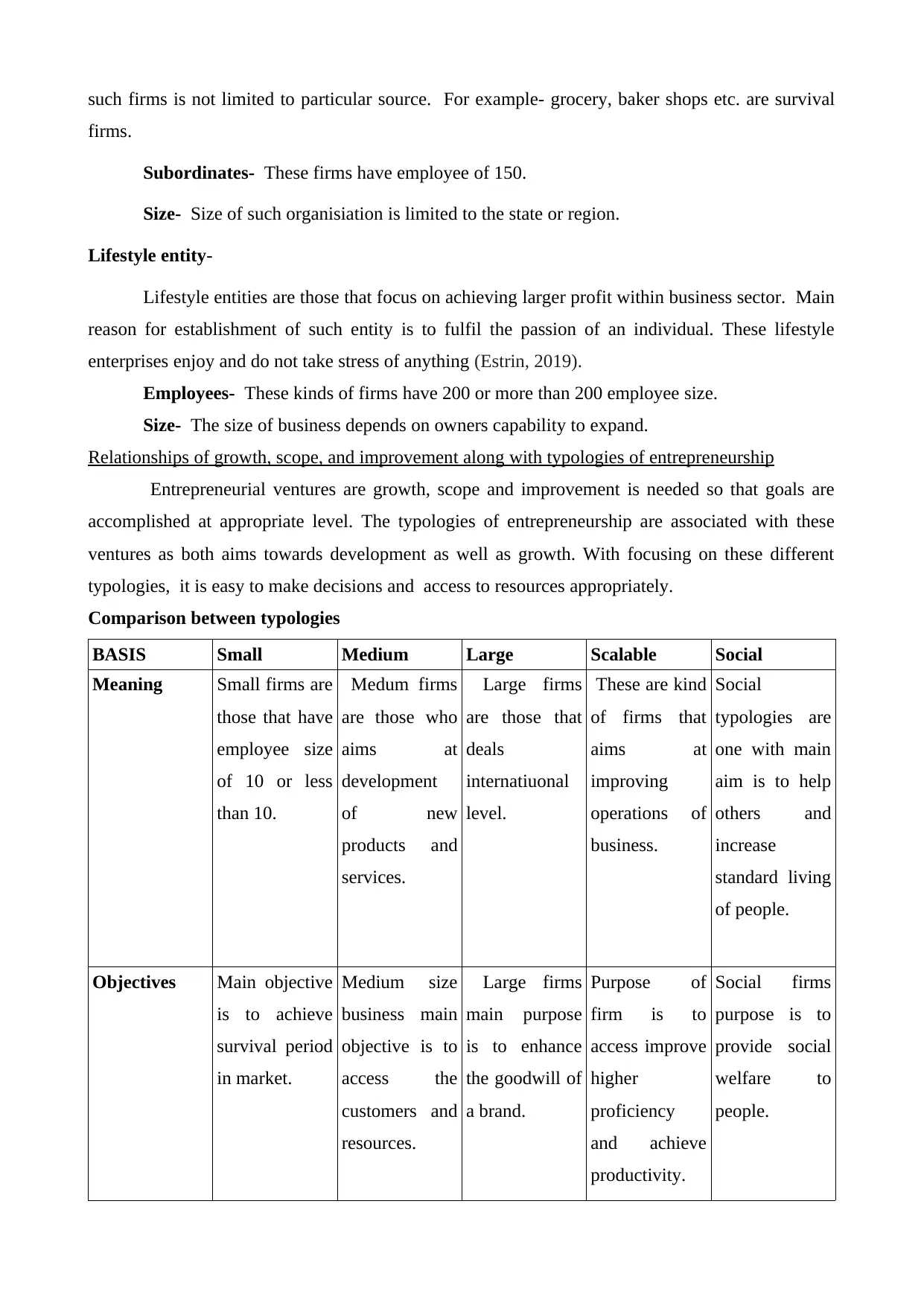
such firms is not limited to particular source. For example- grocery, baker shops etc. are survival
firms.
Subordinates- These firms have employee of 150.
Size- Size of such organisiation is limited to the state or region.
Lifestyle entity-
Lifestyle entities are those that focus on achieving larger profit within business sector. Main
reason for establishment of such entity is to fulfil the passion of an individual. These lifestyle
enterprises enjoy and do not take stress of anything (Estrin, 2019).
Employees- These kinds of firms have 200 or more than 200 employee size.
Size- The size of business depends on owners capability to expand.
Relationships of growth, scope, and improvement along with typologies of entrepreneurship
Entrepreneurial ventures are growth, scope and improvement is needed so that goals are
accomplished at appropriate level. The typologies of entrepreneurship are associated with these
ventures as both aims towards development as well as growth. With focusing on these different
typologies, it is easy to make decisions and access to resources appropriately.
Comparison between typologies
BASIS Small Medium Large Scalable Social
Meaning Small firms are
those that have
employee size
of 10 or less
than 10.
Medum firms
are those who
aims at
development
of new
products and
services.
Large firms
are those that
deals
internatiuonal
level.
These are kind
of firms that
aims at
improving
operations of
business.
Social
typologies are
one with main
aim is to help
others and
increase
standard living
of people.
Objectives Main objective
is to achieve
survival period
in market.
Medium size
business main
objective is to
access the
customers and
resources.
Large firms
main purpose
is to enhance
the goodwill of
a brand.
Purpose of
firm is to
access improve
higher
proficiency
and achieve
productivity.
Social firms
purpose is to
provide social
welfare to
people.
firms.
Subordinates- These firms have employee of 150.
Size- Size of such organisiation is limited to the state or region.
Lifestyle entity-
Lifestyle entities are those that focus on achieving larger profit within business sector. Main
reason for establishment of such entity is to fulfil the passion of an individual. These lifestyle
enterprises enjoy and do not take stress of anything (Estrin, 2019).
Employees- These kinds of firms have 200 or more than 200 employee size.
Size- The size of business depends on owners capability to expand.
Relationships of growth, scope, and improvement along with typologies of entrepreneurship
Entrepreneurial ventures are growth, scope and improvement is needed so that goals are
accomplished at appropriate level. The typologies of entrepreneurship are associated with these
ventures as both aims towards development as well as growth. With focusing on these different
typologies, it is easy to make decisions and access to resources appropriately.
Comparison between typologies
BASIS Small Medium Large Scalable Social
Meaning Small firms are
those that have
employee size
of 10 or less
than 10.
Medum firms
are those who
aims at
development
of new
products and
services.
Large firms
are those that
deals
internatiuonal
level.
These are kind
of firms that
aims at
improving
operations of
business.
Social
typologies are
one with main
aim is to help
others and
increase
standard living
of people.
Objectives Main objective
is to achieve
survival period
in market.
Medium size
business main
objective is to
access the
customers and
resources.
Large firms
main purpose
is to enhance
the goodwill of
a brand.
Purpose of
firm is to
access improve
higher
proficiency
and achieve
productivity.
Social firms
purpose is to
provide social
welfare to
people.
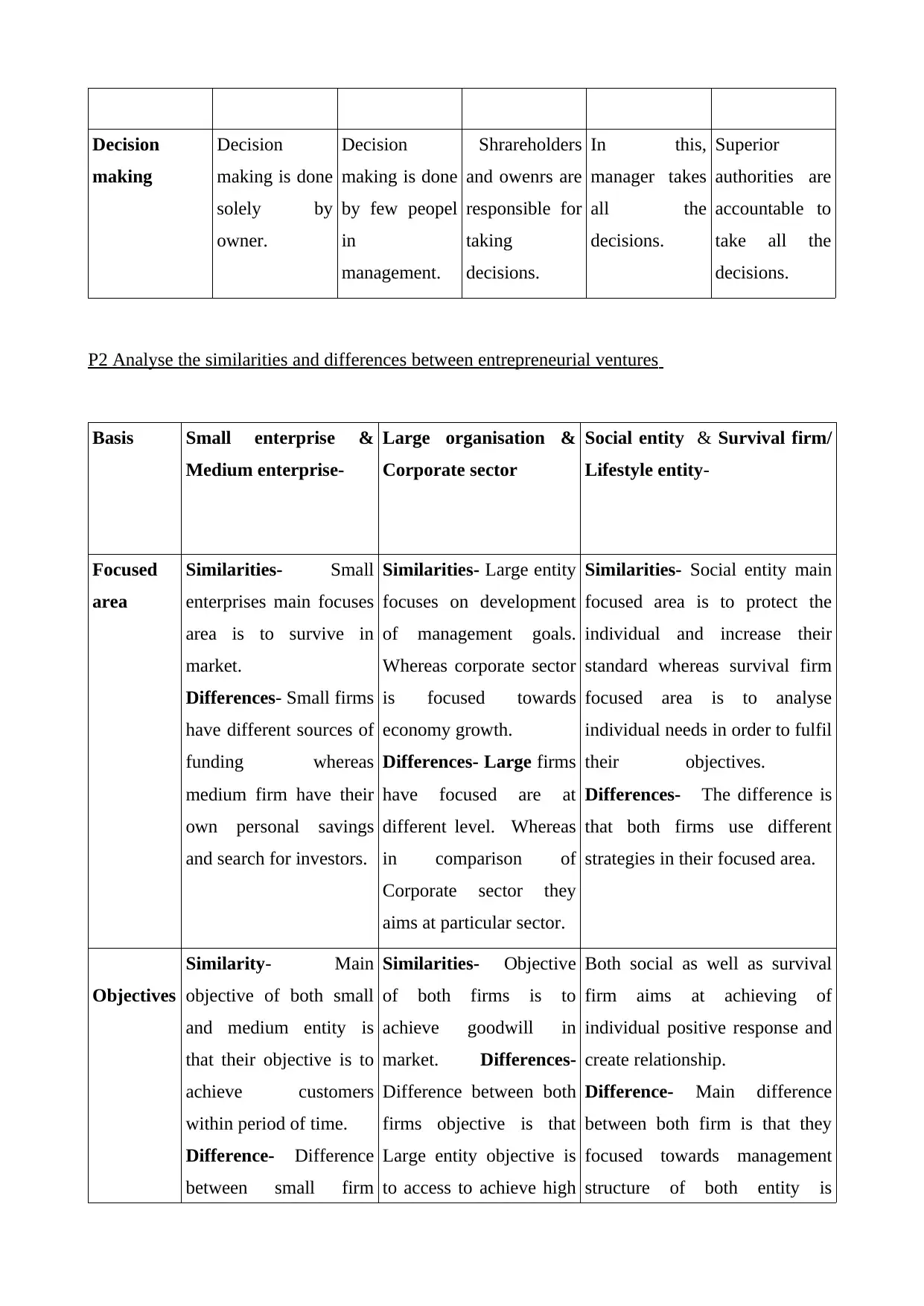
Decision
making
Decision
making is done
solely by
owner.
Decision
making is done
by few peopel
in
management.
Shrareholders
and owenrs are
responsible for
taking
decisions.
In this,
manager takes
all the
decisions.
Superior
authorities are
accountable to
take all the
decisions.
P2 Analyse the similarities and differences between entrepreneurial ventures
Basis Small enterprise &
Medium enterprise-
Large organisation &
Corporate sector
Social entity & Survival firm/
Lifestyle entity-
Focused
area
Similarities- Small
enterprises main focuses
area is to survive in
market.
Differences- Small firms
have different sources of
funding whereas
medium firm have their
own personal savings
and search for investors.
Similarities- Large entity
focuses on development
of management goals.
Whereas corporate sector
is focused towards
economy growth.
Differences- Large firms
have focused are at
different level. Whereas
in comparison of
Corporate sector they
aims at particular sector.
Similarities- Social entity main
focused area is to protect the
individual and increase their
standard whereas survival firm
focused area is to analyse
individual needs in order to fulfil
their objectives.
Differences- The difference is
that both firms use different
strategies in their focused area.
Objectives
Similarity- Main
objective of both small
and medium entity is
that their objective is to
achieve customers
within period of time.
Difference- Difference
between small firm
Similarities- Objective
of both firms is to
achieve goodwill in
market. Differences-
Difference between both
firms objective is that
Large entity objective is
to access to achieve high
Both social as well as survival
firm aims at achieving of
individual positive response and
create relationship.
Difference- Main difference
between both firm is that they
focused towards management
structure of both entity is
making
Decision
making is done
solely by
owner.
Decision
making is done
by few peopel
in
management.
Shrareholders
and owenrs are
responsible for
taking
decisions.
In this,
manager takes
all the
decisions.
Superior
authorities are
accountable to
take all the
decisions.
P2 Analyse the similarities and differences between entrepreneurial ventures
Basis Small enterprise &
Medium enterprise-
Large organisation &
Corporate sector
Social entity & Survival firm/
Lifestyle entity-
Focused
area
Similarities- Small
enterprises main focuses
area is to survive in
market.
Differences- Small firms
have different sources of
funding whereas
medium firm have their
own personal savings
and search for investors.
Similarities- Large entity
focuses on development
of management goals.
Whereas corporate sector
is focused towards
economy growth.
Differences- Large firms
have focused are at
different level. Whereas
in comparison of
Corporate sector they
aims at particular sector.
Similarities- Social entity main
focused area is to protect the
individual and increase their
standard whereas survival firm
focused area is to analyse
individual needs in order to fulfil
their objectives.
Differences- The difference is
that both firms use different
strategies in their focused area.
Objectives
Similarity- Main
objective of both small
and medium entity is
that their objective is to
achieve customers
within period of time.
Difference- Difference
between small firm
Similarities- Objective
of both firms is to
achieve goodwill in
market. Differences-
Difference between both
firms objective is that
Large entity objective is
to access to achieve high
Both social as well as survival
firm aims at achieving of
individual positive response and
create relationship.
Difference- Main difference
between both firm is that they
focused towards management
structure of both entity is
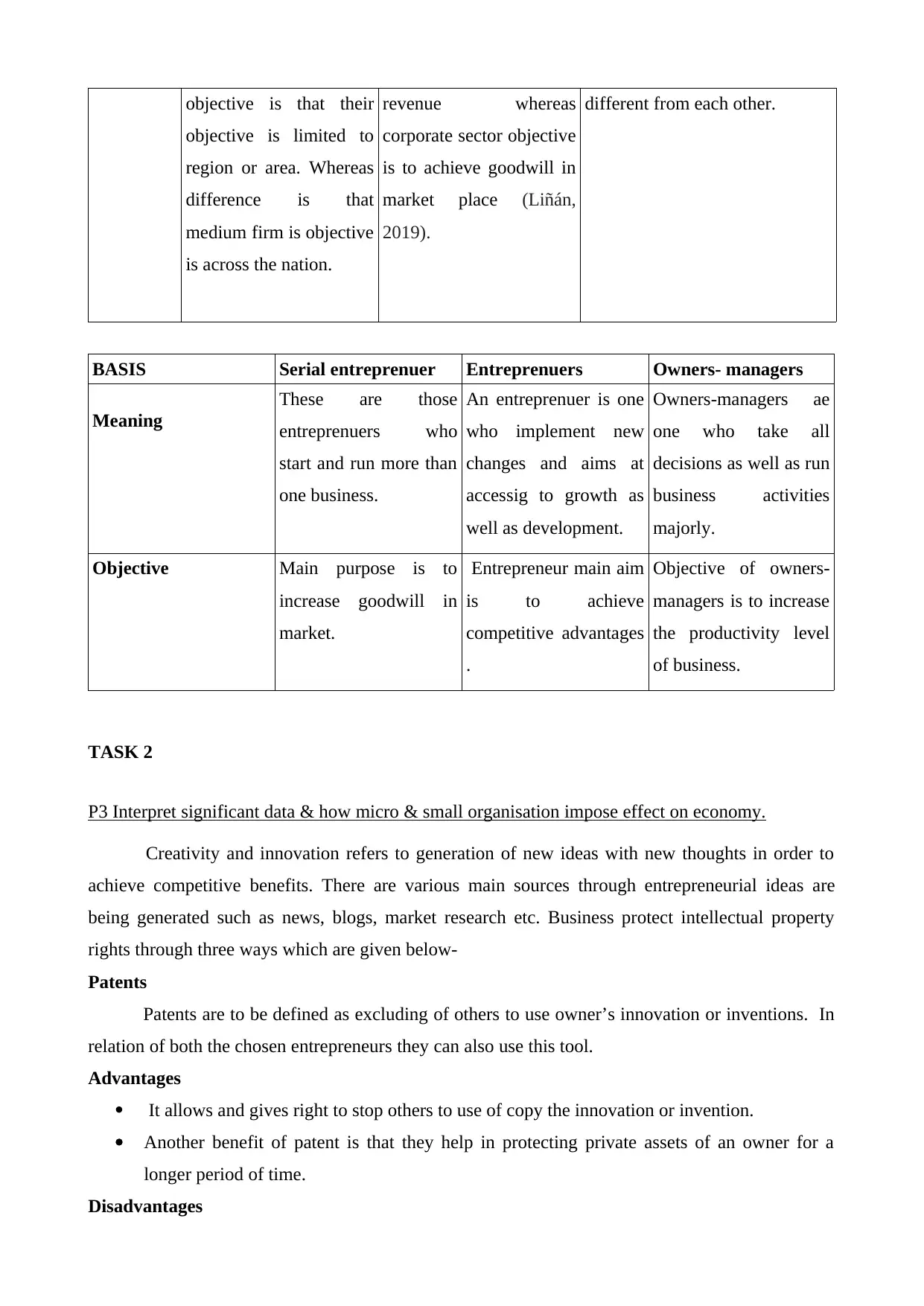
objective is that their
objective is limited to
region or area. Whereas
difference is that
medium firm is objective
is across the nation.
revenue whereas
corporate sector objective
is to achieve goodwill in
market place (Liñán,
2019).
different from each other.
BASIS Serial entreprenuer Entreprenuers Owners- managers
Meaning
These are those
entreprenuers who
start and run more than
one business.
An entreprenuer is one
who implement new
changes and aims at
accessig to growth as
well as development.
Owners-managers ae
one who take all
decisions as well as run
business activities
majorly.
Objective Main purpose is to
increase goodwill in
market.
Entrepreneur main aim
is to achieve
competitive advantages
.
Objective of owners-
managers is to increase
the productivity level
of business.
TASK 2
P3 Interpret significant data & how micro & small organisation impose effect on economy.
Creativity and innovation refers to generation of new ideas with new thoughts in order to
achieve competitive benefits. There are various main sources through entrepreneurial ideas are
being generated such as news, blogs, market research etc. Business protect intellectual property
rights through three ways which are given below-
Patents
Patents are to be defined as excluding of others to use owner’s innovation or inventions. In
relation of both the chosen entrepreneurs they can also use this tool.
Advantages
It allows and gives right to stop others to use of copy the innovation or invention.
Another benefit of patent is that they help in protecting private assets of an owner for a
longer period of time.
Disadvantages
objective is limited to
region or area. Whereas
difference is that
medium firm is objective
is across the nation.
revenue whereas
corporate sector objective
is to achieve goodwill in
market place (Liñán,
2019).
different from each other.
BASIS Serial entreprenuer Entreprenuers Owners- managers
Meaning
These are those
entreprenuers who
start and run more than
one business.
An entreprenuer is one
who implement new
changes and aims at
accessig to growth as
well as development.
Owners-managers ae
one who take all
decisions as well as run
business activities
majorly.
Objective Main purpose is to
increase goodwill in
market.
Entrepreneur main aim
is to achieve
competitive advantages
.
Objective of owners-
managers is to increase
the productivity level
of business.
TASK 2
P3 Interpret significant data & how micro & small organisation impose effect on economy.
Creativity and innovation refers to generation of new ideas with new thoughts in order to
achieve competitive benefits. There are various main sources through entrepreneurial ideas are
being generated such as news, blogs, market research etc. Business protect intellectual property
rights through three ways which are given below-
Patents
Patents are to be defined as excluding of others to use owner’s innovation or inventions. In
relation of both the chosen entrepreneurs they can also use this tool.
Advantages
It allows and gives right to stop others to use of copy the innovation or invention.
Another benefit of patent is that they help in protecting private assets of an owner for a
longer period of time.
Disadvantages
Paraphrase This Document
Need a fresh take? Get an instant paraphrase of this document with our AI Paraphraser
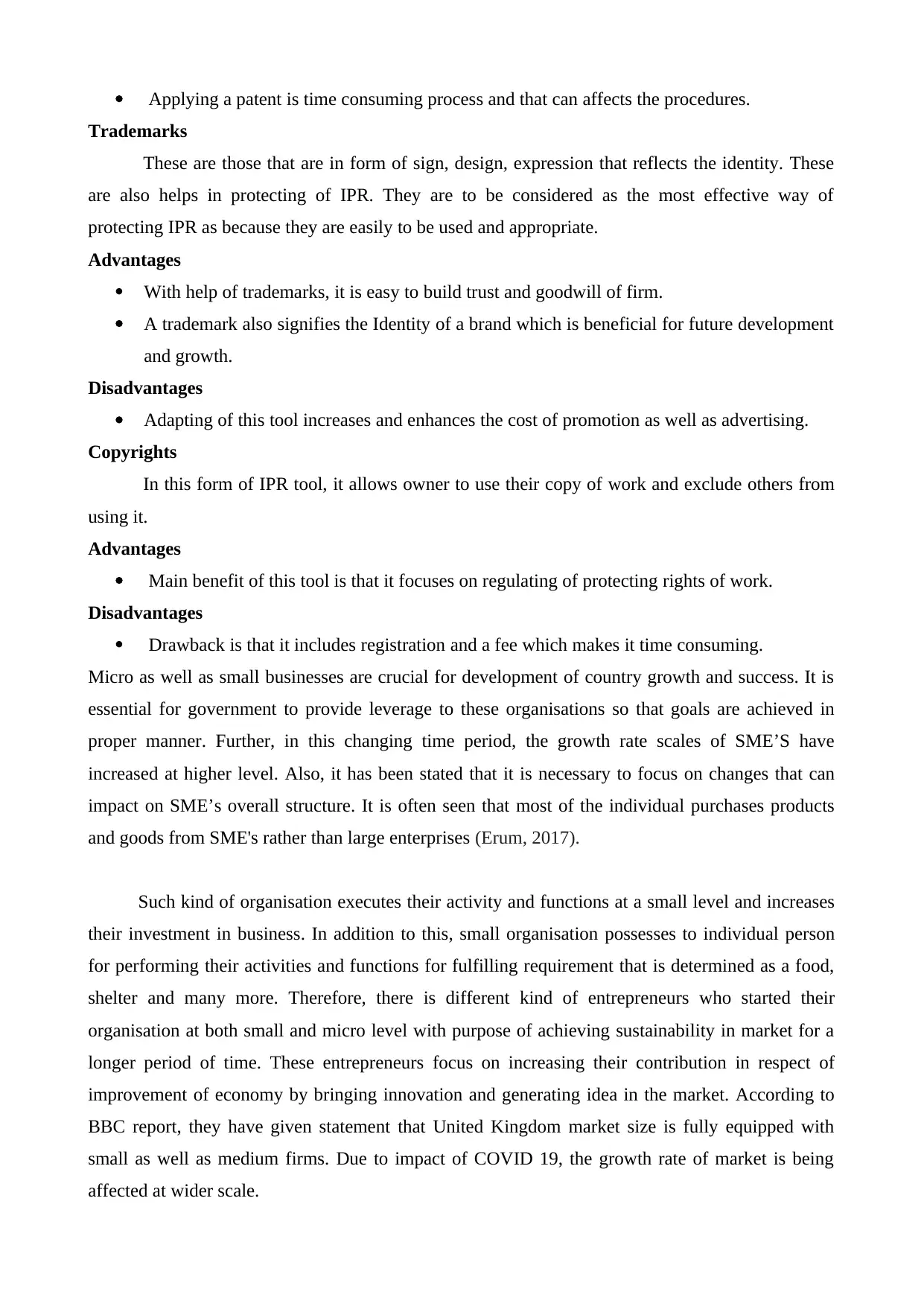
Applying a patent is time consuming process and that can affects the procedures.
Trademarks
These are those that are in form of sign, design, expression that reflects the identity. These
are also helps in protecting of IPR. They are to be considered as the most effective way of
protecting IPR as because they are easily to be used and appropriate.
Advantages
With help of trademarks, it is easy to build trust and goodwill of firm.
A trademark also signifies the Identity of a brand which is beneficial for future development
and growth.
Disadvantages
Adapting of this tool increases and enhances the cost of promotion as well as advertising.
Copyrights
In this form of IPR tool, it allows owner to use their copy of work and exclude others from
using it.
Advantages
Main benefit of this tool is that it focuses on regulating of protecting rights of work.
Disadvantages
Drawback is that it includes registration and a fee which makes it time consuming.
Micro as well as small businesses are crucial for development of country growth and success. It is
essential for government to provide leverage to these organisations so that goals are achieved in
proper manner. Further, in this changing time period, the growth rate scales of SME’S have
increased at higher level. Also, it has been stated that it is necessary to focus on changes that can
impact on SME’s overall structure. It is often seen that most of the individual purchases products
and goods from SME's rather than large enterprises (Erum, 2017).
Such kind of organisation executes their activity and functions at a small level and increases
their investment in business. In addition to this, small organisation possesses to individual person
for performing their activities and functions for fulfilling requirement that is determined as a food,
shelter and many more. Therefore, there is different kind of entrepreneurs who started their
organisation at both small and micro level with purpose of achieving sustainability in market for a
longer period of time. These entrepreneurs focus on increasing their contribution in respect of
improvement of economy by bringing innovation and generating idea in the market. According to
BBC report, they have given statement that United Kingdom market size is fully equipped with
small as well as medium firms. Due to impact of COVID 19, the growth rate of market is being
affected at wider scale.
Trademarks
These are those that are in form of sign, design, expression that reflects the identity. These
are also helps in protecting of IPR. They are to be considered as the most effective way of
protecting IPR as because they are easily to be used and appropriate.
Advantages
With help of trademarks, it is easy to build trust and goodwill of firm.
A trademark also signifies the Identity of a brand which is beneficial for future development
and growth.
Disadvantages
Adapting of this tool increases and enhances the cost of promotion as well as advertising.
Copyrights
In this form of IPR tool, it allows owner to use their copy of work and exclude others from
using it.
Advantages
Main benefit of this tool is that it focuses on regulating of protecting rights of work.
Disadvantages
Drawback is that it includes registration and a fee which makes it time consuming.
Micro as well as small businesses are crucial for development of country growth and success. It is
essential for government to provide leverage to these organisations so that goals are achieved in
proper manner. Further, in this changing time period, the growth rate scales of SME’S have
increased at higher level. Also, it has been stated that it is necessary to focus on changes that can
impact on SME’s overall structure. It is often seen that most of the individual purchases products
and goods from SME's rather than large enterprises (Erum, 2017).
Such kind of organisation executes their activity and functions at a small level and increases
their investment in business. In addition to this, small organisation possesses to individual person
for performing their activities and functions for fulfilling requirement that is determined as a food,
shelter and many more. Therefore, there is different kind of entrepreneurs who started their
organisation at both small and micro level with purpose of achieving sustainability in market for a
longer period of time. These entrepreneurs focus on increasing their contribution in respect of
improvement of economy by bringing innovation and generating idea in the market. According to
BBC report, they have given statement that United Kingdom market size is fully equipped with
small as well as medium firms. Due to impact of COVID 19, the growth rate of market is being
affected at wider scale.
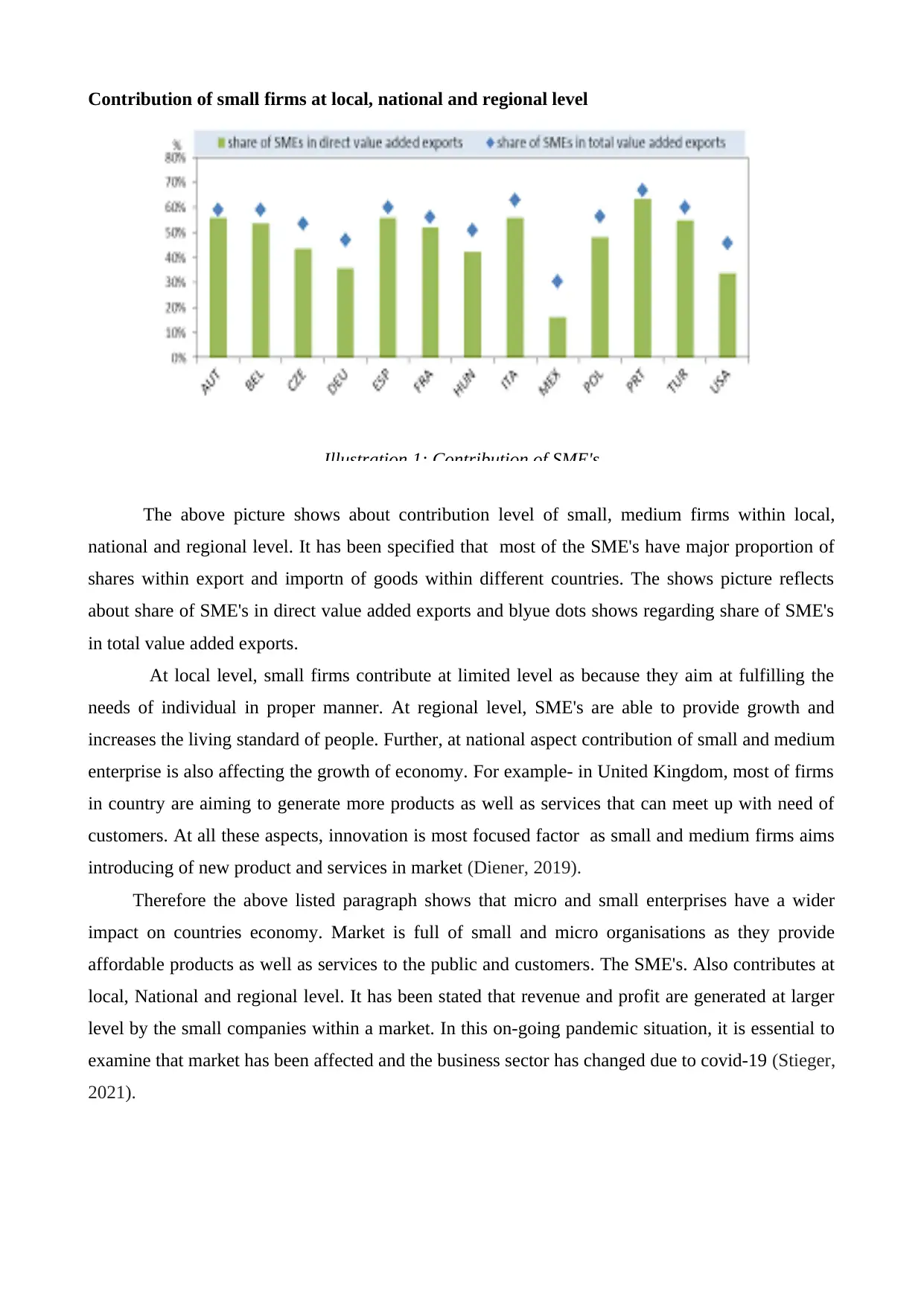
Contribution of small firms at local, national and regional level
The above picture shows about contribution level of small, medium firms within local,
national and regional level. It has been specified that most of the SME's have major proportion of
shares within export and importn of goods within different countries. The shows picture reflects
about share of SME's in direct value added exports and blyue dots shows regarding share of SME's
in total value added exports.
At local level, small firms contribute at limited level as because they aim at fulfilling the
needs of individual in proper manner. At regional level, SME's are able to provide growth and
increases the living standard of people. Further, at national aspect contribution of small and medium
enterprise is also affecting the growth of economy. For example- in United Kingdom, most of firms
in country are aiming to generate more products as well as services that can meet up with need of
customers. At all these aspects, innovation is most focused factor as small and medium firms aims
introducing of new product and services in market (Diener, 2019).
Therefore the above listed paragraph shows that micro and small enterprises have a wider
impact on countries economy. Market is full of small and micro organisations as they provide
affordable products as well as services to the public and customers. The SME's. Also contributes at
local, National and regional level. It has been stated that revenue and profit are generated at larger
level by the small companies within a market. In this on-going pandemic situation, it is essential to
examine that market has been affected and the business sector has changed due to covid-19 (Stieger,
2021).
Illustration 1: Contribution of SME's
The above picture shows about contribution level of small, medium firms within local,
national and regional level. It has been specified that most of the SME's have major proportion of
shares within export and importn of goods within different countries. The shows picture reflects
about share of SME's in direct value added exports and blyue dots shows regarding share of SME's
in total value added exports.
At local level, small firms contribute at limited level as because they aim at fulfilling the
needs of individual in proper manner. At regional level, SME's are able to provide growth and
increases the living standard of people. Further, at national aspect contribution of small and medium
enterprise is also affecting the growth of economy. For example- in United Kingdom, most of firms
in country are aiming to generate more products as well as services that can meet up with need of
customers. At all these aspects, innovation is most focused factor as small and medium firms aims
introducing of new product and services in market (Diener, 2019).
Therefore the above listed paragraph shows that micro and small enterprises have a wider
impact on countries economy. Market is full of small and micro organisations as they provide
affordable products as well as services to the public and customers. The SME's. Also contributes at
local, National and regional level. It has been stated that revenue and profit are generated at larger
level by the small companies within a market. In this on-going pandemic situation, it is essential to
examine that market has been affected and the business sector has changed due to covid-19 (Stieger,
2021).
Illustration 1: Contribution of SME's
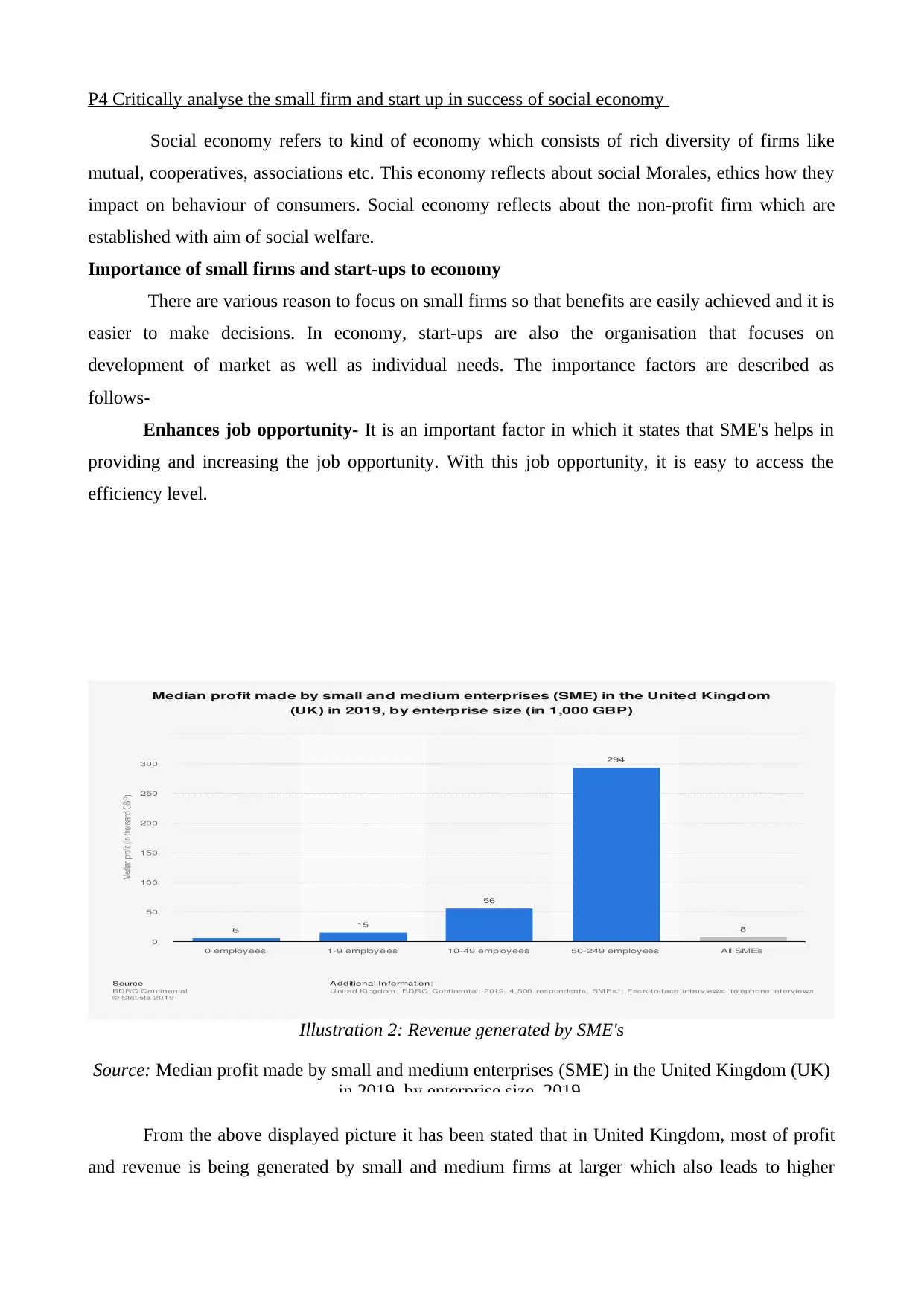
P4 Critically analyse the small firm and start up in success of social economy
Social economy refers to kind of economy which consists of rich diversity of firms like
mutual, cooperatives, associations etc. This economy reflects about social Morales, ethics how they
impact on behaviour of consumers. Social economy reflects about the non-profit firm which are
established with aim of social welfare.
Importance of small firms and start-ups to economy
There are various reason to focus on small firms so that benefits are easily achieved and it is
easier to make decisions. In economy, start-ups are also the organisation that focuses on
development of market as well as individual needs. The importance factors are described as
follows-
Enhances job opportunity- It is an important factor in which it states that SME's helps in
providing and increasing the job opportunity. With this job opportunity, it is easy to access the
efficiency level.
From the above displayed picture it has been stated that in United Kingdom, most of profit
and revenue is being generated by small and medium firms at larger which also leads to higher
Illustration 2: Revenue generated by SME's
Source: Median profit made by small and medium enterprises (SME) in the United Kingdom (UK)
in 2019, by enterprise size, 2019.
Social economy refers to kind of economy which consists of rich diversity of firms like
mutual, cooperatives, associations etc. This economy reflects about social Morales, ethics how they
impact on behaviour of consumers. Social economy reflects about the non-profit firm which are
established with aim of social welfare.
Importance of small firms and start-ups to economy
There are various reason to focus on small firms so that benefits are easily achieved and it is
easier to make decisions. In economy, start-ups are also the organisation that focuses on
development of market as well as individual needs. The importance factors are described as
follows-
Enhances job opportunity- It is an important factor in which it states that SME's helps in
providing and increasing the job opportunity. With this job opportunity, it is easy to access the
efficiency level.
From the above displayed picture it has been stated that in United Kingdom, most of profit
and revenue is being generated by small and medium firms at larger which also leads to higher
Illustration 2: Revenue generated by SME's
Source: Median profit made by small and medium enterprises (SME) in the United Kingdom (UK)
in 2019, by enterprise size, 2019.
Secure Best Marks with AI Grader
Need help grading? Try our AI Grader for instant feedback on your assignments.
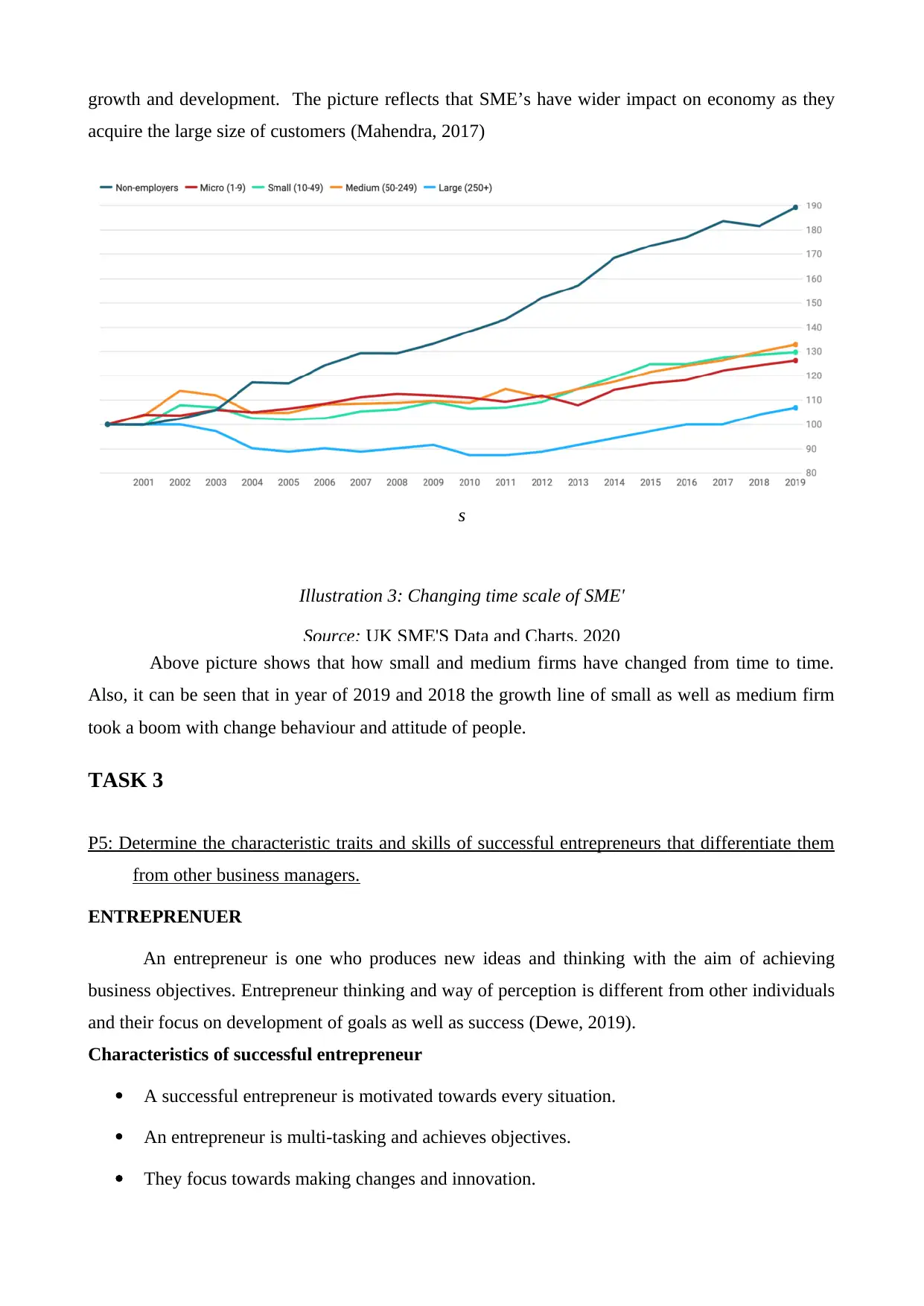
growth and development. The picture reflects that SME’s have wider impact on economy as they
acquire the large size of customers (Mahendra, 2017)
Above picture shows that how small and medium firms have changed from time to time.
Also, it can be seen that in year of 2019 and 2018 the growth line of small as well as medium firm
took a boom with change behaviour and attitude of people.
TASK 3
P5: Determine the characteristic traits and skills of successful entrepreneurs that differentiate them
from other business managers.
ENTREPRENUER
An entrepreneur is one who produces new ideas and thinking with the aim of achieving
business objectives. Entrepreneur thinking and way of perception is different from other individuals
and their focus on development of goals as well as success (Dewe, 2019).
Characteristics of successful entrepreneur
A successful entrepreneur is motivated towards every situation.
An entrepreneur is multi-tasking and achieves objectives.
They focus towards making changes and innovation.
s
Illustration 3: Changing time scale of SME'
Source: UK SME'S Data and Charts, 2020
acquire the large size of customers (Mahendra, 2017)
Above picture shows that how small and medium firms have changed from time to time.
Also, it can be seen that in year of 2019 and 2018 the growth line of small as well as medium firm
took a boom with change behaviour and attitude of people.
TASK 3
P5: Determine the characteristic traits and skills of successful entrepreneurs that differentiate them
from other business managers.
ENTREPRENUER
An entrepreneur is one who produces new ideas and thinking with the aim of achieving
business objectives. Entrepreneur thinking and way of perception is different from other individuals
and their focus on development of goals as well as success (Dewe, 2019).
Characteristics of successful entrepreneur
A successful entrepreneur is motivated towards every situation.
An entrepreneur is multi-tasking and achieves objectives.
They focus towards making changes and innovation.
s
Illustration 3: Changing time scale of SME'
Source: UK SME'S Data and Charts, 2020
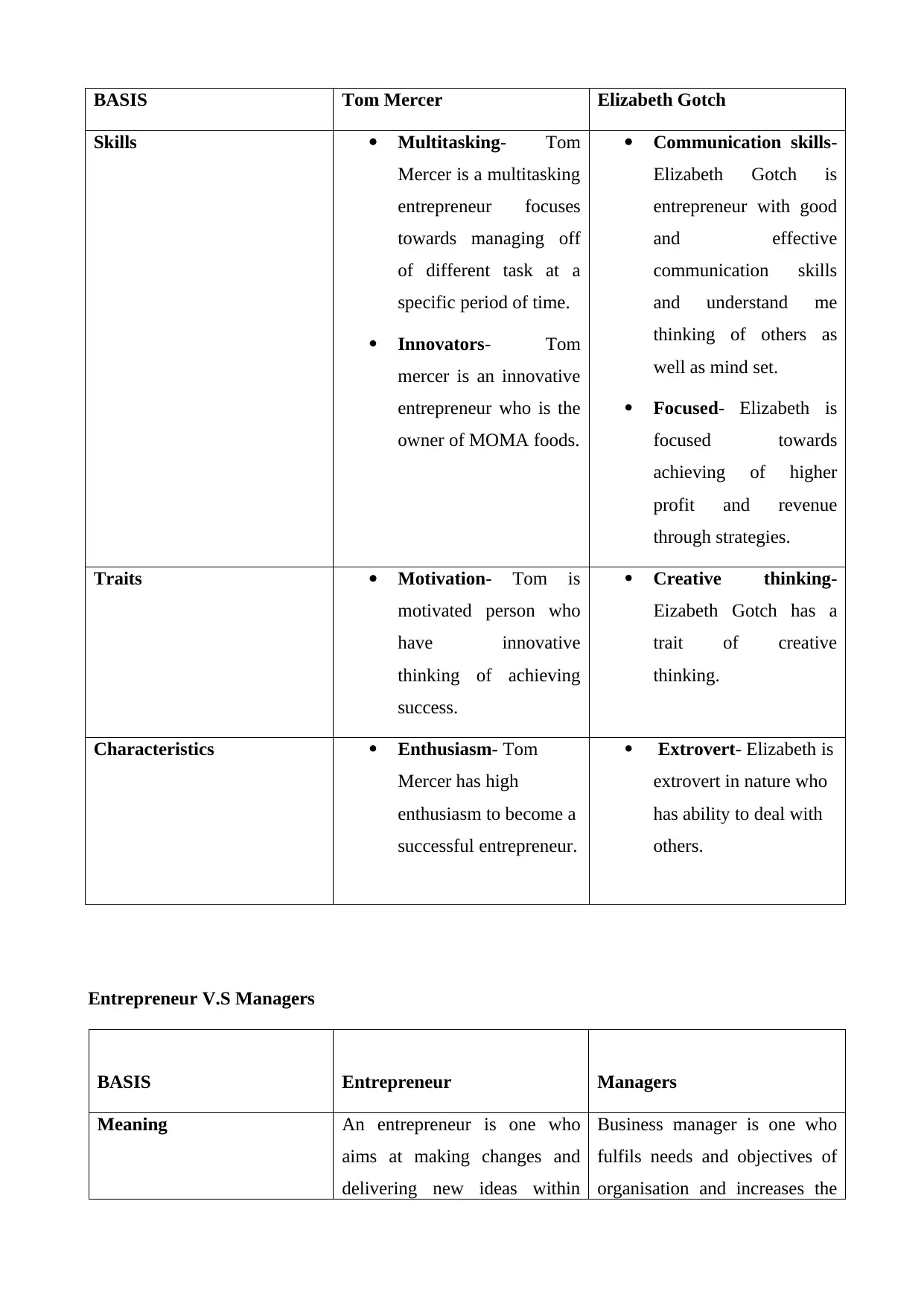
BASIS Tom Mercer Elizabeth Gotch
Skills Multitasking- Tom
Mercer is a multitasking
entrepreneur focuses
towards managing off
of different task at a
specific period of time.
Innovators- Tom
mercer is an innovative
entrepreneur who is the
owner of MOMA foods.
Communication skills-
Elizabeth Gotch is
entrepreneur with good
and effective
communication skills
and understand me
thinking of others as
well as mind set.
Focused- Elizabeth is
focused towards
achieving of higher
profit and revenue
through strategies.
Traits Motivation- Tom is
motivated person who
have innovative
thinking of achieving
success.
Creative thinking-
Eizabeth Gotch has a
trait of creative
thinking.
Characteristics Enthusiasm- Tom
Mercer has high
enthusiasm to become a
successful entrepreneur.
Extrovert- Elizabeth is
extrovert in nature who
has ability to deal with
others.
Entrepreneur V.S Managers
BASIS Entrepreneur Managers
Meaning An entrepreneur is one who
aims at making changes and
delivering new ideas within
Business manager is one who
fulfils needs and objectives of
organisation and increases the
Skills Multitasking- Tom
Mercer is a multitasking
entrepreneur focuses
towards managing off
of different task at a
specific period of time.
Innovators- Tom
mercer is an innovative
entrepreneur who is the
owner of MOMA foods.
Communication skills-
Elizabeth Gotch is
entrepreneur with good
and effective
communication skills
and understand me
thinking of others as
well as mind set.
Focused- Elizabeth is
focused towards
achieving of higher
profit and revenue
through strategies.
Traits Motivation- Tom is
motivated person who
have innovative
thinking of achieving
success.
Creative thinking-
Eizabeth Gotch has a
trait of creative
thinking.
Characteristics Enthusiasm- Tom
Mercer has high
enthusiasm to become a
successful entrepreneur.
Extrovert- Elizabeth is
extrovert in nature who
has ability to deal with
others.
Entrepreneur V.S Managers
BASIS Entrepreneur Managers
Meaning An entrepreneur is one who
aims at making changes and
delivering new ideas within
Business manager is one who
fulfils needs and objectives of
organisation and increases the
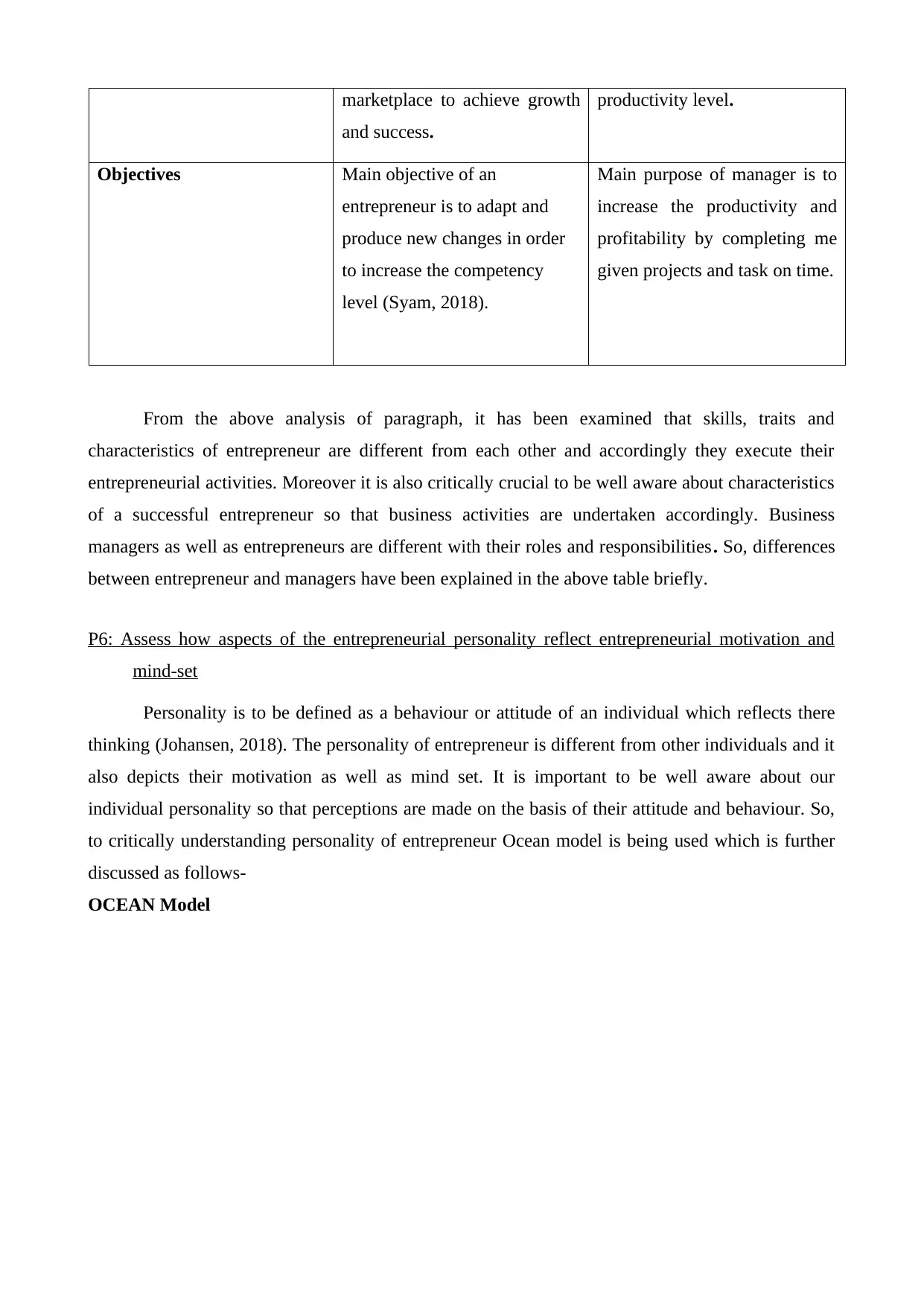
marketplace to achieve growth
and success.
productivity level.
Objectives Main objective of an
entrepreneur is to adapt and
produce new changes in order
to increase the competency
level (Syam, 2018).
Main purpose of manager is to
increase the productivity and
profitability by completing me
given projects and task on time.
From the above analysis of paragraph, it has been examined that skills, traits and
characteristics of entrepreneur are different from each other and accordingly they execute their
entrepreneurial activities. Moreover it is also critically crucial to be well aware about characteristics
of a successful entrepreneur so that business activities are undertaken accordingly. Business
managers as well as entrepreneurs are different with their roles and responsibilities. So, differences
between entrepreneur and managers have been explained in the above table briefly.
P6: Assess how aspects of the entrepreneurial personality reflect entrepreneurial motivation and
mind-set
Personality is to be defined as a behaviour or attitude of an individual which reflects there
thinking (Johansen, 2018). The personality of entrepreneur is different from other individuals and it
also depicts their motivation as well as mind set. It is important to be well aware about our
individual personality so that perceptions are made on the basis of their attitude and behaviour. So,
to critically understanding personality of entrepreneur Ocean model is being used which is further
discussed as follows-
OCEAN Model
and success.
productivity level.
Objectives Main objective of an
entrepreneur is to adapt and
produce new changes in order
to increase the competency
level (Syam, 2018).
Main purpose of manager is to
increase the productivity and
profitability by completing me
given projects and task on time.
From the above analysis of paragraph, it has been examined that skills, traits and
characteristics of entrepreneur are different from each other and accordingly they execute their
entrepreneurial activities. Moreover it is also critically crucial to be well aware about characteristics
of a successful entrepreneur so that business activities are undertaken accordingly. Business
managers as well as entrepreneurs are different with their roles and responsibilities. So, differences
between entrepreneur and managers have been explained in the above table briefly.
P6: Assess how aspects of the entrepreneurial personality reflect entrepreneurial motivation and
mind-set
Personality is to be defined as a behaviour or attitude of an individual which reflects there
thinking (Johansen, 2018). The personality of entrepreneur is different from other individuals and it
also depicts their motivation as well as mind set. It is important to be well aware about our
individual personality so that perceptions are made on the basis of their attitude and behaviour. So,
to critically understanding personality of entrepreneur Ocean model is being used which is further
discussed as follows-
OCEAN Model
Paraphrase This Document
Need a fresh take? Get an instant paraphrase of this document with our AI Paraphraser
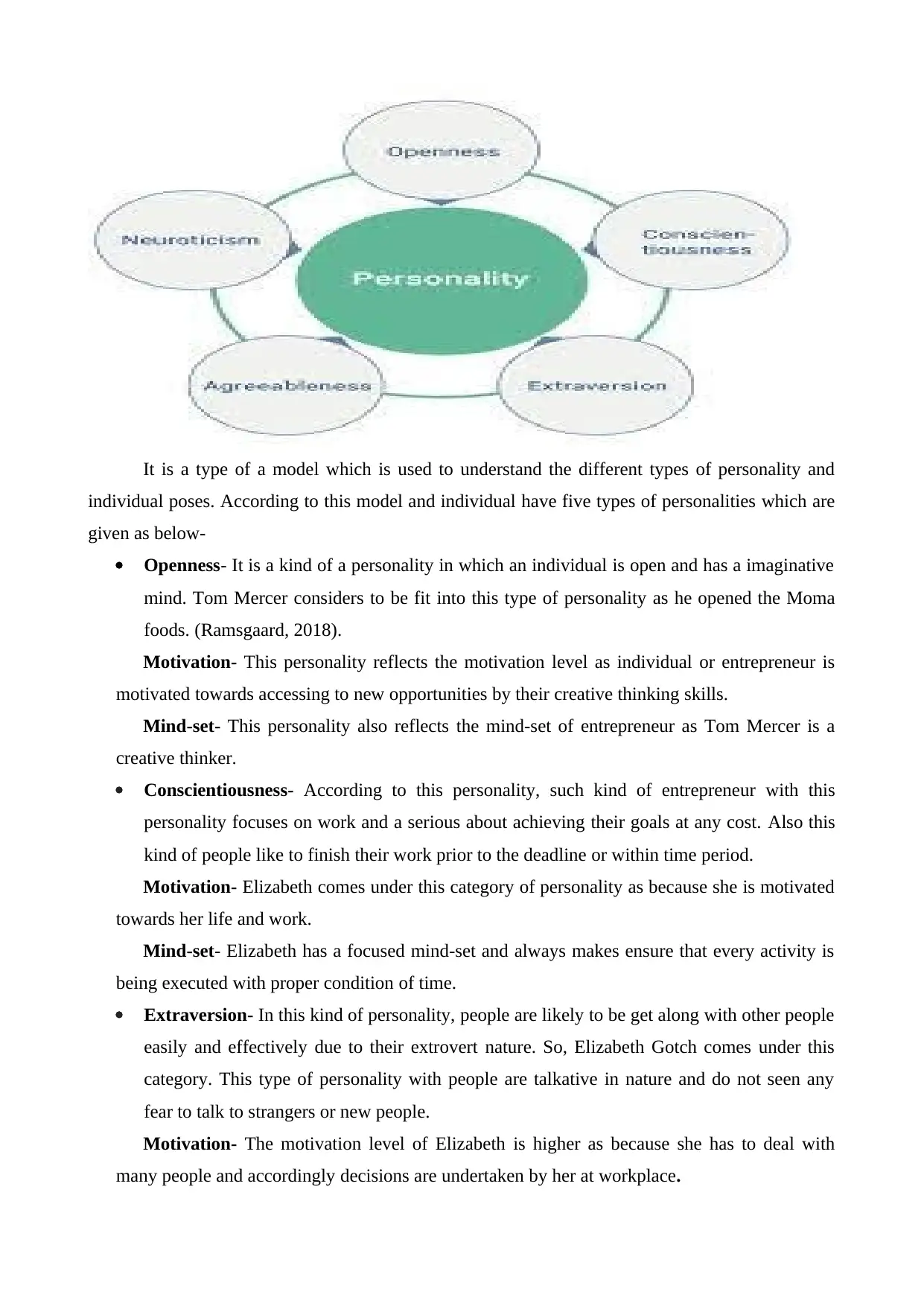
It is a type of a model which is used to understand the different types of personality and
individual poses. According to this model and individual have five types of personalities which are
given as below-
Openness- It is a kind of a personality in which an individual is open and has a imaginative
mind. Tom Mercer considers to be fit into this type of personality as he opened the Moma
foods. (Ramsgaard, 2018).
Motivation- This personality reflects the motivation level as individual or entrepreneur is
motivated towards accessing to new opportunities by their creative thinking skills.
Mind-set- This personality also reflects the mind-set of entrepreneur as Tom Mercer is a
creative thinker.
Conscientiousness- According to this personality, such kind of entrepreneur with this
personality focuses on work and a serious about achieving their goals at any cost. Also this
kind of people like to finish their work prior to the deadline or within time period.
Motivation- Elizabeth comes under this category of personality as because she is motivated
towards her life and work.
Mind-set- Elizabeth has a focused mind-set and always makes ensure that every activity is
being executed with proper condition of time.
Extraversion- In this kind of personality, people are likely to be get along with other people
easily and effectively due to their extrovert nature. So, Elizabeth Gotch comes under this
category. This type of personality with people are talkative in nature and do not seen any
fear to talk to strangers or new people.
Motivation- The motivation level of Elizabeth is higher as because she has to deal with
many people and accordingly decisions are undertaken by her at workplace.
individual poses. According to this model and individual have five types of personalities which are
given as below-
Openness- It is a kind of a personality in which an individual is open and has a imaginative
mind. Tom Mercer considers to be fit into this type of personality as he opened the Moma
foods. (Ramsgaard, 2018).
Motivation- This personality reflects the motivation level as individual or entrepreneur is
motivated towards accessing to new opportunities by their creative thinking skills.
Mind-set- This personality also reflects the mind-set of entrepreneur as Tom Mercer is a
creative thinker.
Conscientiousness- According to this personality, such kind of entrepreneur with this
personality focuses on work and a serious about achieving their goals at any cost. Also this
kind of people like to finish their work prior to the deadline or within time period.
Motivation- Elizabeth comes under this category of personality as because she is motivated
towards her life and work.
Mind-set- Elizabeth has a focused mind-set and always makes ensure that every activity is
being executed with proper condition of time.
Extraversion- In this kind of personality, people are likely to be get along with other people
easily and effectively due to their extrovert nature. So, Elizabeth Gotch comes under this
category. This type of personality with people are talkative in nature and do not seen any
fear to talk to strangers or new people.
Motivation- The motivation level of Elizabeth is higher as because she has to deal with
many people and accordingly decisions are undertaken by her at workplace.
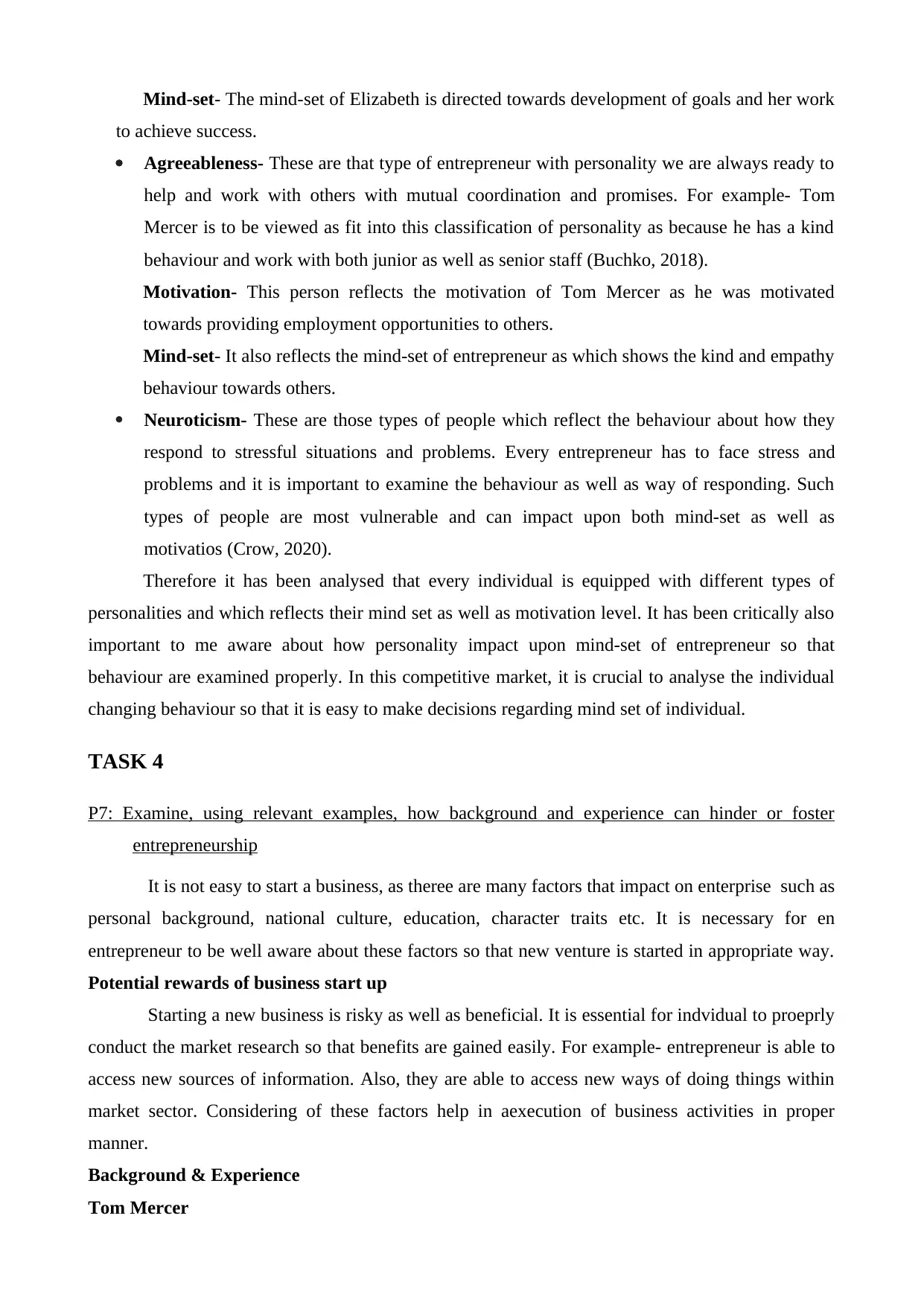
Mind-set- The mind-set of Elizabeth is directed towards development of goals and her work
to achieve success.
Agreeableness- These are that type of entrepreneur with personality we are always ready to
help and work with others with mutual coordination and promises. For example- Tom
Mercer is to be viewed as fit into this classification of personality as because he has a kind
behaviour and work with both junior as well as senior staff (Buchko, 2018).
Motivation- This person reflects the motivation of Tom Mercer as he was motivated
towards providing employment opportunities to others.
Mind-set- It also reflects the mind-set of entrepreneur as which shows the kind and empathy
behaviour towards others.
Neuroticism- These are those types of people which reflect the behaviour about how they
respond to stressful situations and problems. Every entrepreneur has to face stress and
problems and it is important to examine the behaviour as well as way of responding. Such
types of people are most vulnerable and can impact upon both mind-set as well as
motivatios (Crow, 2020).
Therefore it has been analysed that every individual is equipped with different types of
personalities and which reflects their mind set as well as motivation level. It has been critically also
important to me aware about how personality impact upon mind-set of entrepreneur so that
behaviour are examined properly. In this competitive market, it is crucial to analyse the individual
changing behaviour so that it is easy to make decisions regarding mind set of individual.
TASK 4
P7: Examine, using relevant examples, how background and experience can hinder or foster
entrepreneurship
It is not easy to start a business, as theree are many factors that impact on enterprise such as
personal background, national culture, education, character traits etc. It is necessary for en
entrepreneur to be well aware about these factors so that new venture is started in appropriate way.
Potential rewards of business start up
Starting a new business is risky as well as beneficial. It is essential for indvidual to proeprly
conduct the market research so that benefits are gained easily. For example- entrepreneur is able to
access new sources of information. Also, they are able to access new ways of doing things within
market sector. Considering of these factors help in aexecution of business activities in proper
manner.
Background & Experience
Tom Mercer
to achieve success.
Agreeableness- These are that type of entrepreneur with personality we are always ready to
help and work with others with mutual coordination and promises. For example- Tom
Mercer is to be viewed as fit into this classification of personality as because he has a kind
behaviour and work with both junior as well as senior staff (Buchko, 2018).
Motivation- This person reflects the motivation of Tom Mercer as he was motivated
towards providing employment opportunities to others.
Mind-set- It also reflects the mind-set of entrepreneur as which shows the kind and empathy
behaviour towards others.
Neuroticism- These are those types of people which reflect the behaviour about how they
respond to stressful situations and problems. Every entrepreneur has to face stress and
problems and it is important to examine the behaviour as well as way of responding. Such
types of people are most vulnerable and can impact upon both mind-set as well as
motivatios (Crow, 2020).
Therefore it has been analysed that every individual is equipped with different types of
personalities and which reflects their mind set as well as motivation level. It has been critically also
important to me aware about how personality impact upon mind-set of entrepreneur so that
behaviour are examined properly. In this competitive market, it is crucial to analyse the individual
changing behaviour so that it is easy to make decisions regarding mind set of individual.
TASK 4
P7: Examine, using relevant examples, how background and experience can hinder or foster
entrepreneurship
It is not easy to start a business, as theree are many factors that impact on enterprise such as
personal background, national culture, education, character traits etc. It is necessary for en
entrepreneur to be well aware about these factors so that new venture is started in appropriate way.
Potential rewards of business start up
Starting a new business is risky as well as beneficial. It is essential for indvidual to proeprly
conduct the market research so that benefits are gained easily. For example- entrepreneur is able to
access new sources of information. Also, they are able to access new ways of doing things within
market sector. Considering of these factors help in aexecution of business activities in proper
manner.
Background & Experience
Tom Mercer
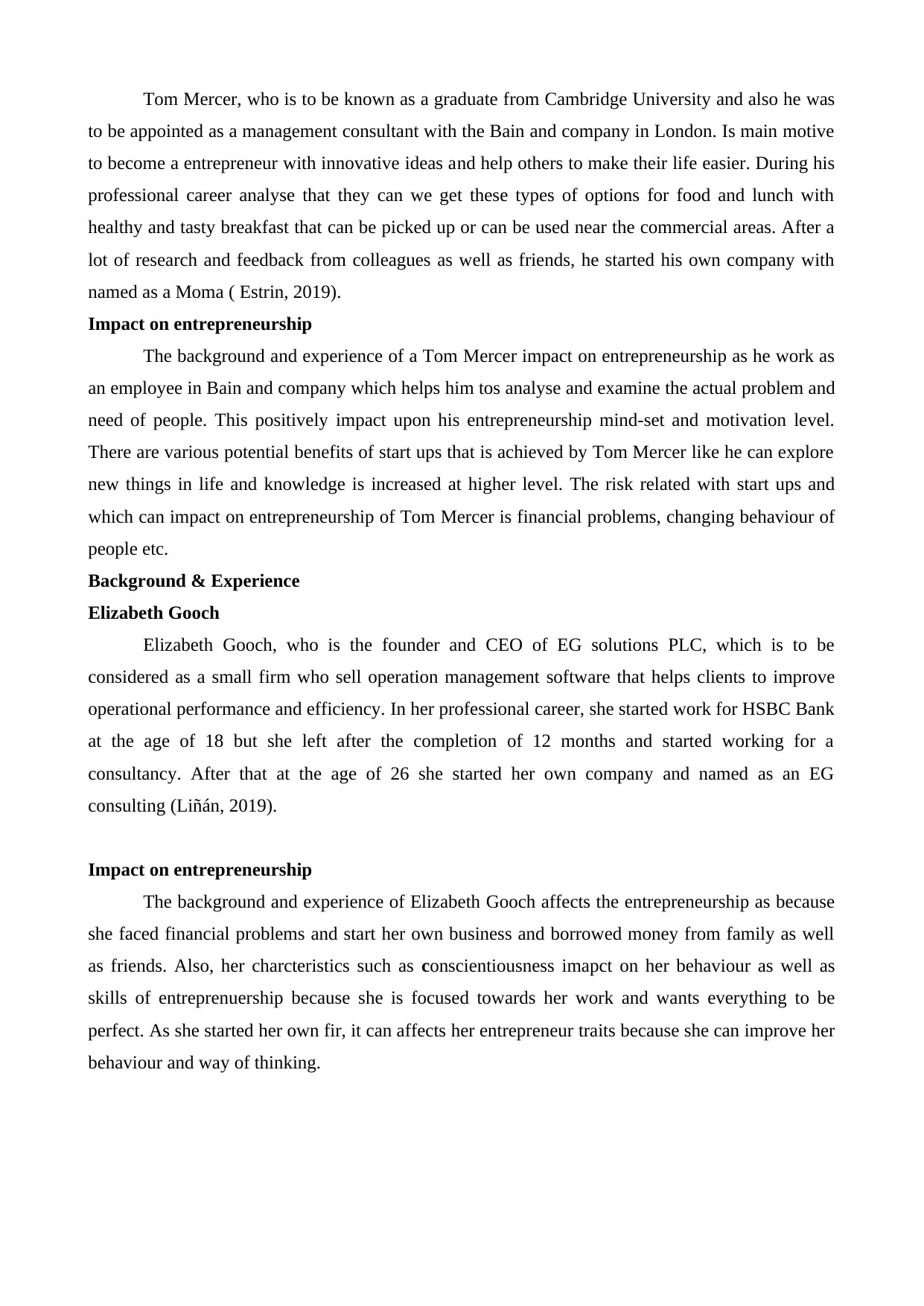
Tom Mercer, who is to be known as a graduate from Cambridge University and also he was
to be appointed as a management consultant with the Bain and company in London. Is main motive
to become a entrepreneur with innovative ideas and help others to make their life easier. During his
professional career analyse that they can we get these types of options for food and lunch with
healthy and tasty breakfast that can be picked up or can be used near the commercial areas. After a
lot of research and feedback from colleagues as well as friends, he started his own company with
named as a Moma ( Estrin, 2019).
Impact on entrepreneurship
The background and experience of a Tom Mercer impact on entrepreneurship as he work as
an employee in Bain and company which helps him tos analyse and examine the actual problem and
need of people. This positively impact upon his entrepreneurship mind-set and motivation level.
There are various potential benefits of start ups that is achieved by Tom Mercer like he can explore
new things in life and knowledge is increased at higher level. The risk related with start ups and
which can impact on entrepreneurship of Tom Mercer is financial problems, changing behaviour of
people etc.
Background & Experience
Elizabeth Gooch
Elizabeth Gooch, who is the founder and CEO of EG solutions PLC, which is to be
considered as a small firm who sell operation management software that helps clients to improve
operational performance and efficiency. In her professional career, she started work for HSBC Bank
at the age of 18 but she left after the completion of 12 months and started working for a
consultancy. After that at the age of 26 she started her own company and named as an EG
consulting (Liñán, 2019).
Impact on entrepreneurship
The background and experience of Elizabeth Gooch affects the entrepreneurship as because
she faced financial problems and start her own business and borrowed money from family as well
as friends. Also, her charcteristics such as conscientiousness imapct on her behaviour as well as
skills of entreprenuership because she is focused towards her work and wants everything to be
perfect. As she started her own fir, it can affects her entrepreneur traits because she can improve her
behaviour and way of thinking.
to be appointed as a management consultant with the Bain and company in London. Is main motive
to become a entrepreneur with innovative ideas and help others to make their life easier. During his
professional career analyse that they can we get these types of options for food and lunch with
healthy and tasty breakfast that can be picked up or can be used near the commercial areas. After a
lot of research and feedback from colleagues as well as friends, he started his own company with
named as a Moma ( Estrin, 2019).
Impact on entrepreneurship
The background and experience of a Tom Mercer impact on entrepreneurship as he work as
an employee in Bain and company which helps him tos analyse and examine the actual problem and
need of people. This positively impact upon his entrepreneurship mind-set and motivation level.
There are various potential benefits of start ups that is achieved by Tom Mercer like he can explore
new things in life and knowledge is increased at higher level. The risk related with start ups and
which can impact on entrepreneurship of Tom Mercer is financial problems, changing behaviour of
people etc.
Background & Experience
Elizabeth Gooch
Elizabeth Gooch, who is the founder and CEO of EG solutions PLC, which is to be
considered as a small firm who sell operation management software that helps clients to improve
operational performance and efficiency. In her professional career, she started work for HSBC Bank
at the age of 18 but she left after the completion of 12 months and started working for a
consultancy. After that at the age of 26 she started her own company and named as an EG
consulting (Liñán, 2019).
Impact on entrepreneurship
The background and experience of Elizabeth Gooch affects the entrepreneurship as because
she faced financial problems and start her own business and borrowed money from family as well
as friends. Also, her charcteristics such as conscientiousness imapct on her behaviour as well as
skills of entreprenuership because she is focused towards her work and wants everything to be
perfect. As she started her own fir, it can affects her entrepreneur traits because she can improve her
behaviour and way of thinking.
Secure Best Marks with AI Grader
Need help grading? Try our AI Grader for instant feedback on your assignments.
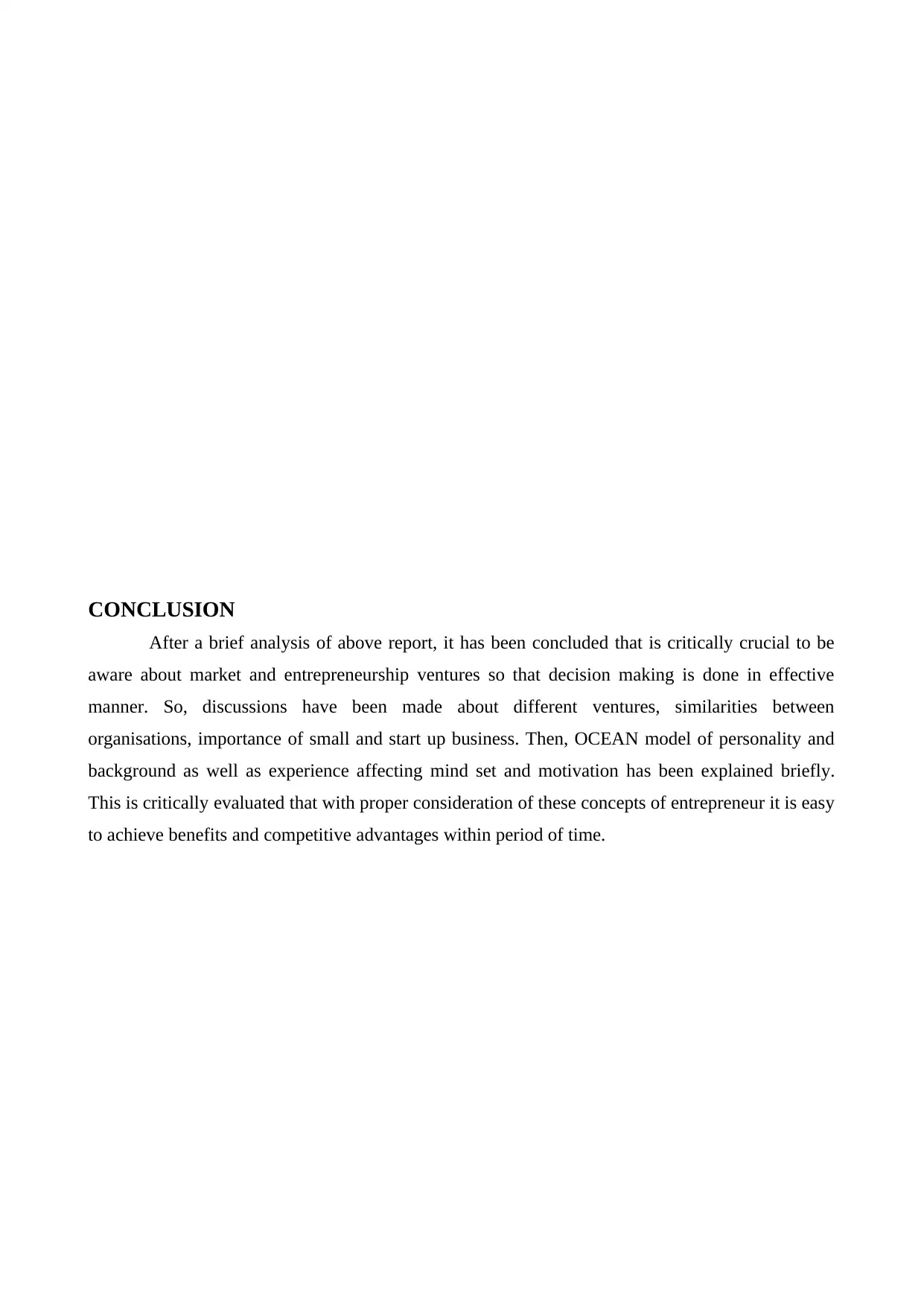
CONCLUSION
After a brief analysis of above report, it has been concluded that is critically crucial to be
aware about market and entrepreneurship ventures so that decision making is done in effective
manner. So, discussions have been made about different ventures, similarities between
organisations, importance of small and start up business. Then, OCEAN model of personality and
background as well as experience affecting mind set and motivation has been explained briefly.
This is critically evaluated that with proper consideration of these concepts of entrepreneur it is easy
to achieve benefits and competitive advantages within period of time.
After a brief analysis of above report, it has been concluded that is critically crucial to be
aware about market and entrepreneurship ventures so that decision making is done in effective
manner. So, discussions have been made about different ventures, similarities between
organisations, importance of small and start up business. Then, OCEAN model of personality and
background as well as experience affecting mind set and motivation has been explained briefly.
This is critically evaluated that with proper consideration of these concepts of entrepreneur it is easy
to achieve benefits and competitive advantages within period of time.
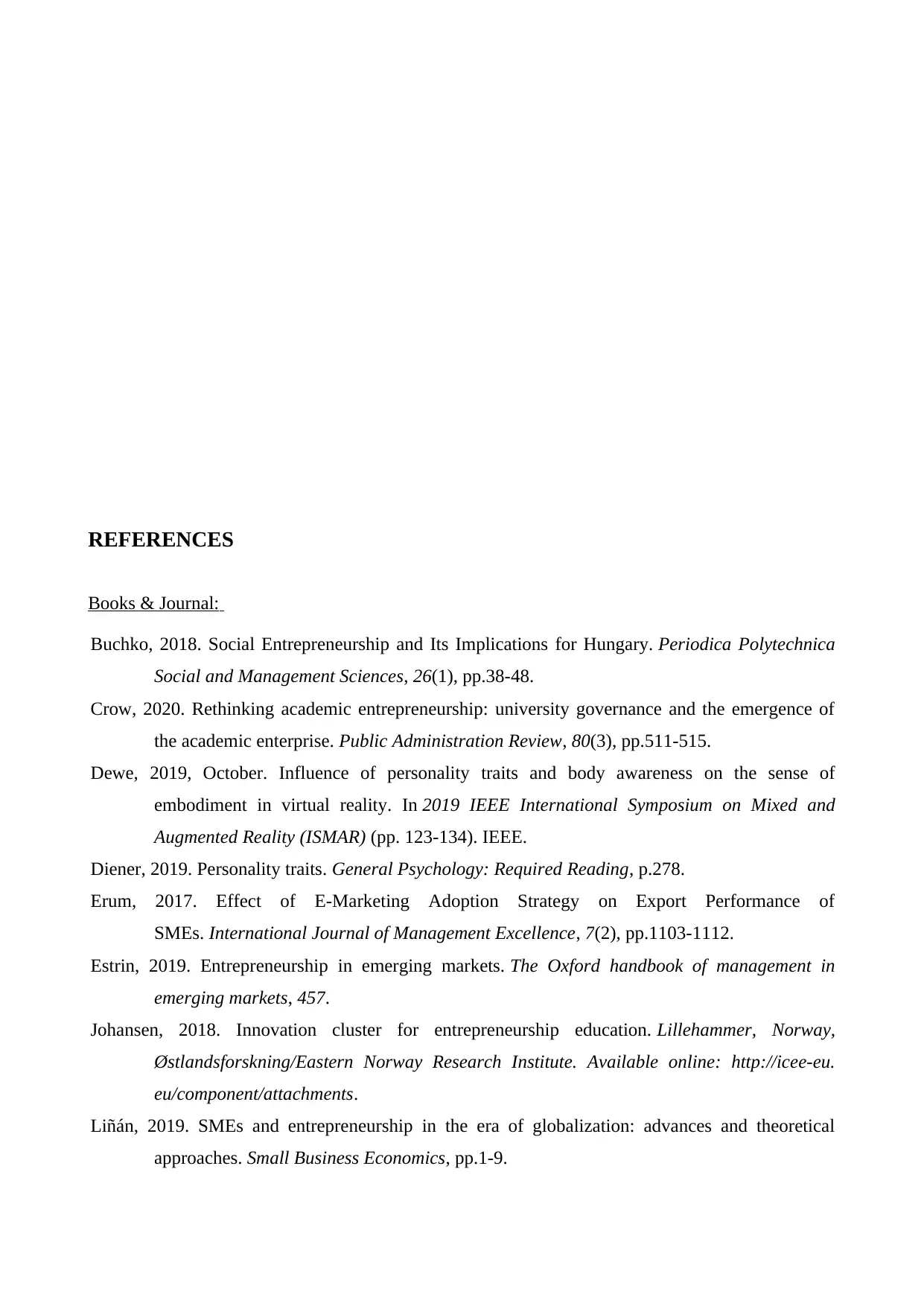
REFERENCES
Books & Journal:
Buchko, 2018. Social Entrepreneurship and Its Implications for Hungary. Periodica Polytechnica
Social and Management Sciences, 26(1), pp.38-48.
Crow, 2020. Rethinking academic entrepreneurship: university governance and the emergence of
the academic enterprise. Public Administration Review, 80(3), pp.511-515.
Dewe, 2019, October. Influence of personality traits and body awareness on the sense of
embodiment in virtual reality. In 2019 IEEE International Symposium on Mixed and
Augmented Reality (ISMAR) (pp. 123-134). IEEE.
Diener, 2019. Personality traits. General Psychology: Required Reading, p.278.
Erum, 2017. Effect of E-Marketing Adoption Strategy on Export Performance of
SMEs. International Journal of Management Excellence, 7(2), pp.1103-1112.
Estrin, 2019. Entrepreneurship in emerging markets. The Oxford handbook of management in
emerging markets, 457.
Johansen, 2018. Innovation cluster for entrepreneurship education. Lillehammer, Norway,
Østlandsforskning/Eastern Norway Research Institute. Available online: http://icee-eu.
eu/component/attachments.
Liñán, 2019. SMEs and entrepreneurship in the era of globalization: advances and theoretical
approaches. Small Business Economics, pp.1-9.
Books & Journal:
Buchko, 2018. Social Entrepreneurship and Its Implications for Hungary. Periodica Polytechnica
Social and Management Sciences, 26(1), pp.38-48.
Crow, 2020. Rethinking academic entrepreneurship: university governance and the emergence of
the academic enterprise. Public Administration Review, 80(3), pp.511-515.
Dewe, 2019, October. Influence of personality traits and body awareness on the sense of
embodiment in virtual reality. In 2019 IEEE International Symposium on Mixed and
Augmented Reality (ISMAR) (pp. 123-134). IEEE.
Diener, 2019. Personality traits. General Psychology: Required Reading, p.278.
Erum, 2017. Effect of E-Marketing Adoption Strategy on Export Performance of
SMEs. International Journal of Management Excellence, 7(2), pp.1103-1112.
Estrin, 2019. Entrepreneurship in emerging markets. The Oxford handbook of management in
emerging markets, 457.
Johansen, 2018. Innovation cluster for entrepreneurship education. Lillehammer, Norway,
Østlandsforskning/Eastern Norway Research Institute. Available online: http://icee-eu.
eu/component/attachments.
Liñán, 2019. SMEs and entrepreneurship in the era of globalization: advances and theoretical
approaches. Small Business Economics, pp.1-9.
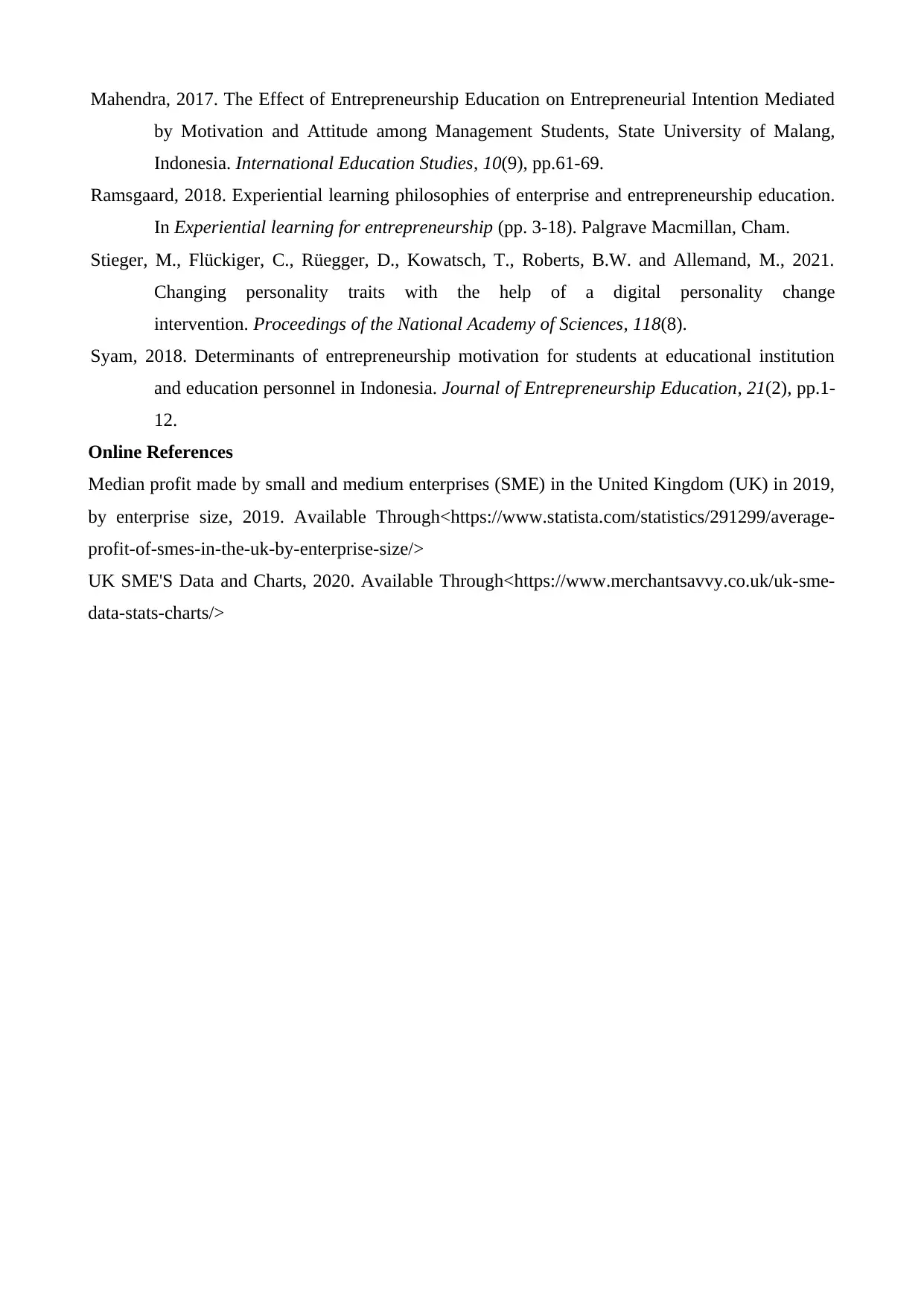
Mahendra, 2017. The Effect of Entrepreneurship Education on Entrepreneurial Intention Mediated
by Motivation and Attitude among Management Students, State University of Malang,
Indonesia. International Education Studies, 10(9), pp.61-69.
Ramsgaard, 2018. Experiential learning philosophies of enterprise and entrepreneurship education.
In Experiential learning for entrepreneurship (pp. 3-18). Palgrave Macmillan, Cham.
Stieger, M., Flückiger, C., Rüegger, D., Kowatsch, T., Roberts, B.W. and Allemand, M., 2021.
Changing personality traits with the help of a digital personality change
intervention. Proceedings of the National Academy of Sciences, 118(8).
Syam, 2018. Determinants of entrepreneurship motivation for students at educational institution
and education personnel in Indonesia. Journal of Entrepreneurship Education, 21(2), pp.1-
12.
Online References
Median profit made by small and medium enterprises (SME) in the United Kingdom (UK) in 2019,
by enterprise size, 2019. Available Through<https://www.statista.com/statistics/291299/average-
profit-of-smes-in-the-uk-by-enterprise-size/>
UK SME'S Data and Charts, 2020. Available Through<https://www.merchantsavvy.co.uk/uk-sme-
data-stats-charts/>
by Motivation and Attitude among Management Students, State University of Malang,
Indonesia. International Education Studies, 10(9), pp.61-69.
Ramsgaard, 2018. Experiential learning philosophies of enterprise and entrepreneurship education.
In Experiential learning for entrepreneurship (pp. 3-18). Palgrave Macmillan, Cham.
Stieger, M., Flückiger, C., Rüegger, D., Kowatsch, T., Roberts, B.W. and Allemand, M., 2021.
Changing personality traits with the help of a digital personality change
intervention. Proceedings of the National Academy of Sciences, 118(8).
Syam, 2018. Determinants of entrepreneurship motivation for students at educational institution
and education personnel in Indonesia. Journal of Entrepreneurship Education, 21(2), pp.1-
12.
Online References
Median profit made by small and medium enterprises (SME) in the United Kingdom (UK) in 2019,
by enterprise size, 2019. Available Through<https://www.statista.com/statistics/291299/average-
profit-of-smes-in-the-uk-by-enterprise-size/>
UK SME'S Data and Charts, 2020. Available Through<https://www.merchantsavvy.co.uk/uk-sme-
data-stats-charts/>
1 out of 19
Related Documents
Your All-in-One AI-Powered Toolkit for Academic Success.
+13062052269
info@desklib.com
Available 24*7 on WhatsApp / Email
![[object Object]](/_next/static/media/star-bottom.7253800d.svg)
Unlock your academic potential
© 2024 | Zucol Services PVT LTD | All rights reserved.





